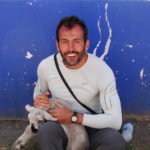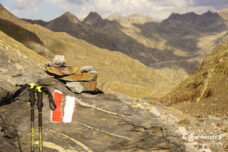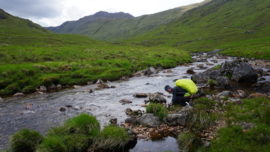Footsteps on the Deserted paths of History!
Μarch 10, 2018
Wādī Aheimar, Arabian desert .
It’s quite hot !
For thirteen days now Argiris and I are crossing the land of Jordan and this stretch in particular is by far the remotest and driest we encountered so far !
We left Petra the previous morning carrying 14 liters of water and by now only 0,5 lt remained. We are thirsty!
«Is this really potable …; »
I wonder, while observing the brown broth we just collected by digging into the sandy and dry stream bed.
«Lets keep it man ! We may need it …!»
Adds Argiris with a meaning, although he finds it equally “attractive”!
Our voices are echoing ! Huge polished walls surround us ! For the last few hours these rocks walls are protecting us by preventing the hot rays of the sun from penetrating this extremely narrow – as we are advancing – gorge.

Here , on the edge of the great Arabian desert, shadow -and water alike – are things that are highly appreciated.
But what on earth are we doing in this barren land , advancing 40+ kms each day closer to Saudi Arabia?

— — —
At the end of February – six months after crossing Iceland – I traveled with my friend Argyris in the Middle East in order to try crossing Jordan from north to south (~ 650km), from the Syrian to Saudi Arabian border !
The so-called “Jordan Trail ” is considered as one of the newest long distance world class trails. It may be officially just 2 years old, but in fact the “Trail” follows ancient commercial, pilgrimage and migratory routes.
Despite the negative media hype regarding the instability in the region and the dangers that the traveller may face there, our point of view is that the world is not exactly like that and that in Jordan we won’t necessarily be less secure than in our own country.
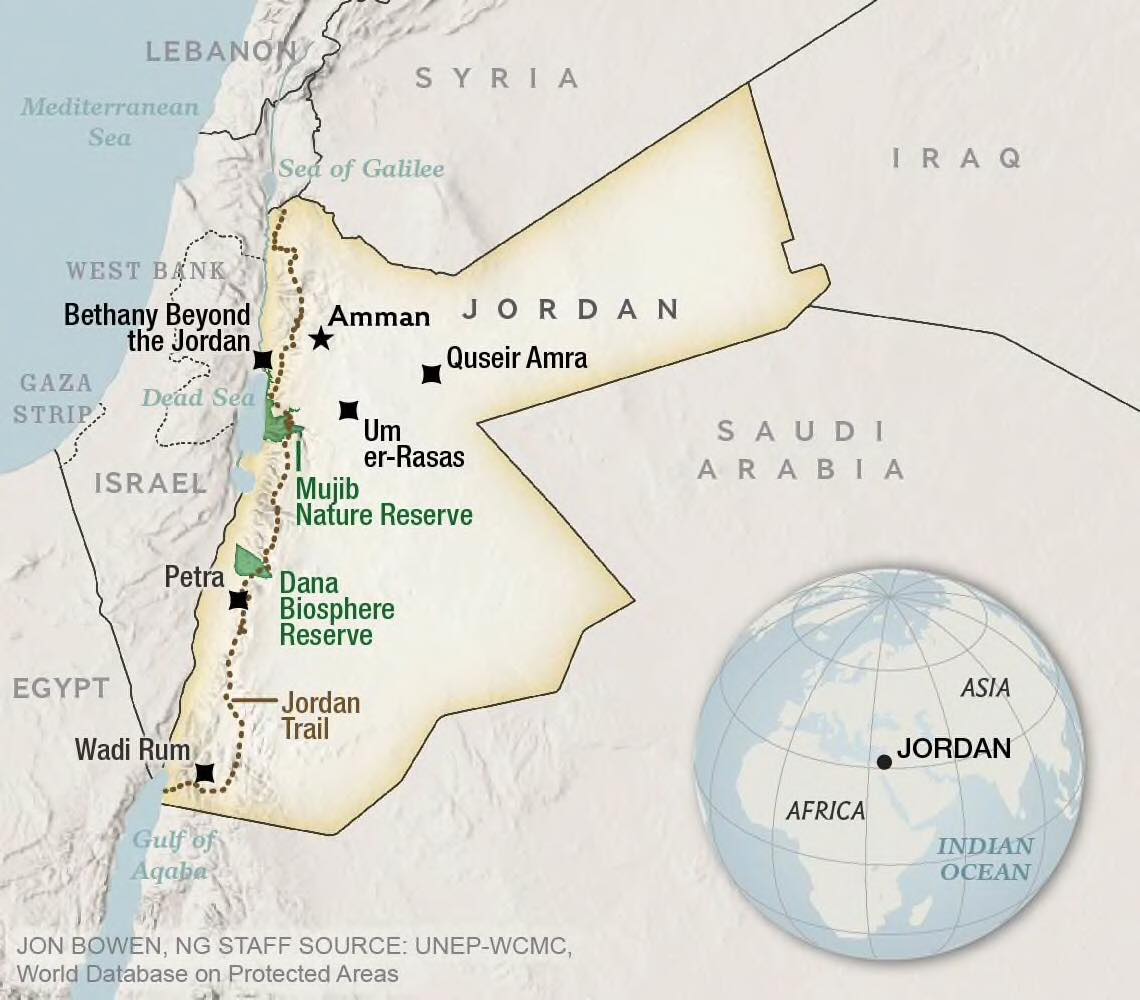
The North
At midday on February 25th, after enjoying an aromatic Arabic coffee with cardamom extract, we loaded our backpacks and started our long walk from the basaltic ruins of Hellenistic Gadara (Umm Qais) pretty close to the northern extremity of the country, overlooking Syria, Palestine and the Sea of Galilee.
Endless hill country with forests, pastures and crops (olive groves, orchards, etc.) dotted the landscape along with historical remnants of the country’s rich and varied past (Hellenistic, Roman, Byzantine, Ottoman, Arabic). That was the scenery like through which we were traveling , always having the fertile Jordan valley on our right.
The first few days were purely introductory in terms of scenery, but gave us an authentic view of Jordan’s rural life and at the same time of the exemplary kindness and hospitality of its people!
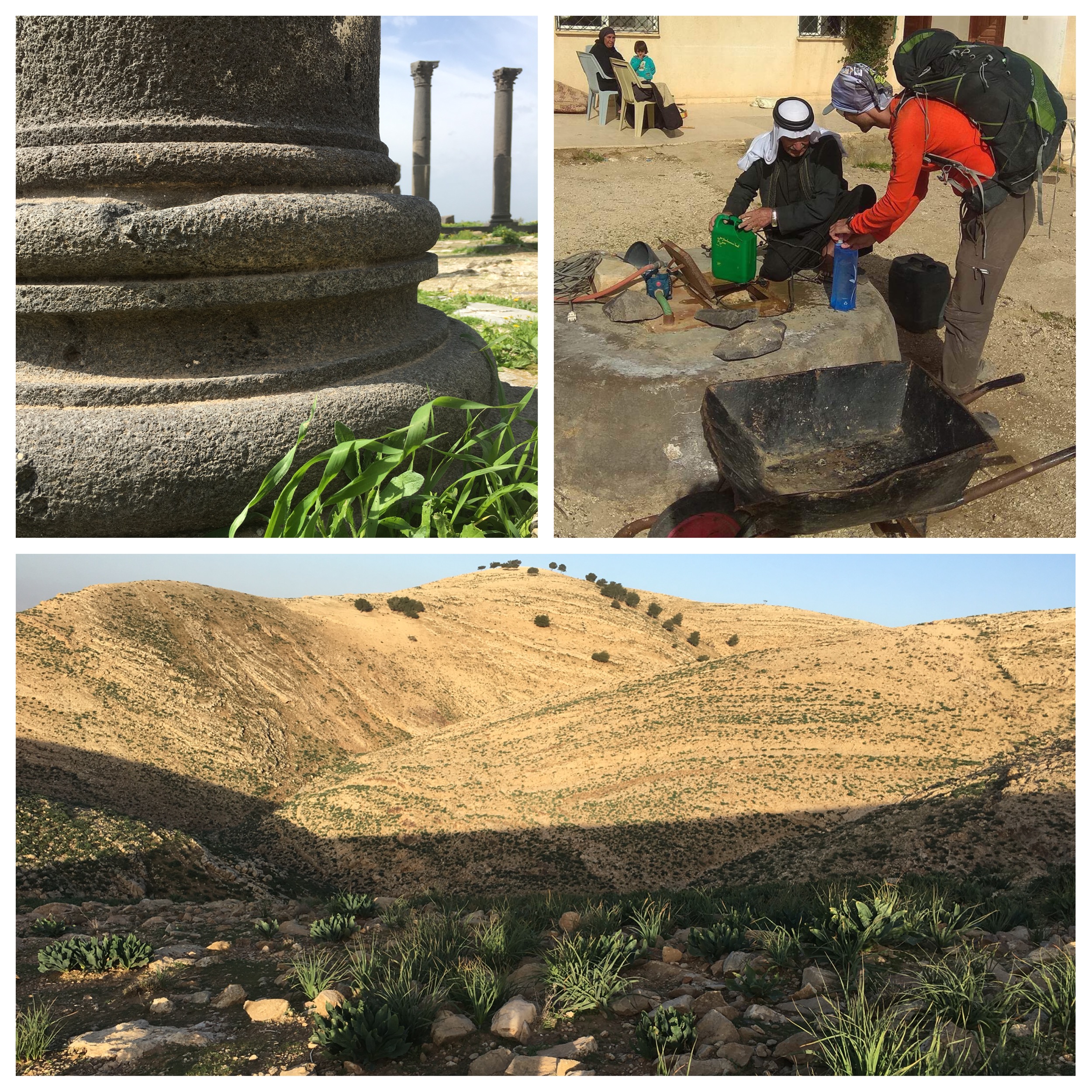
In a country that tends towards desertification, the majority of its population lives in the north, where the soils are far more fertile and the climate reminiscent of the Mediterranean.
Here, tourism is virtually non-existent. People are not accustomed to seeing foreigners and surely not backpackers passing through their fields and villages. A simple greeting was enough for them to invite us for tea and food. That was something that happened with such a frequency that if we accepted all their invitations we would still be there! Literally!!!
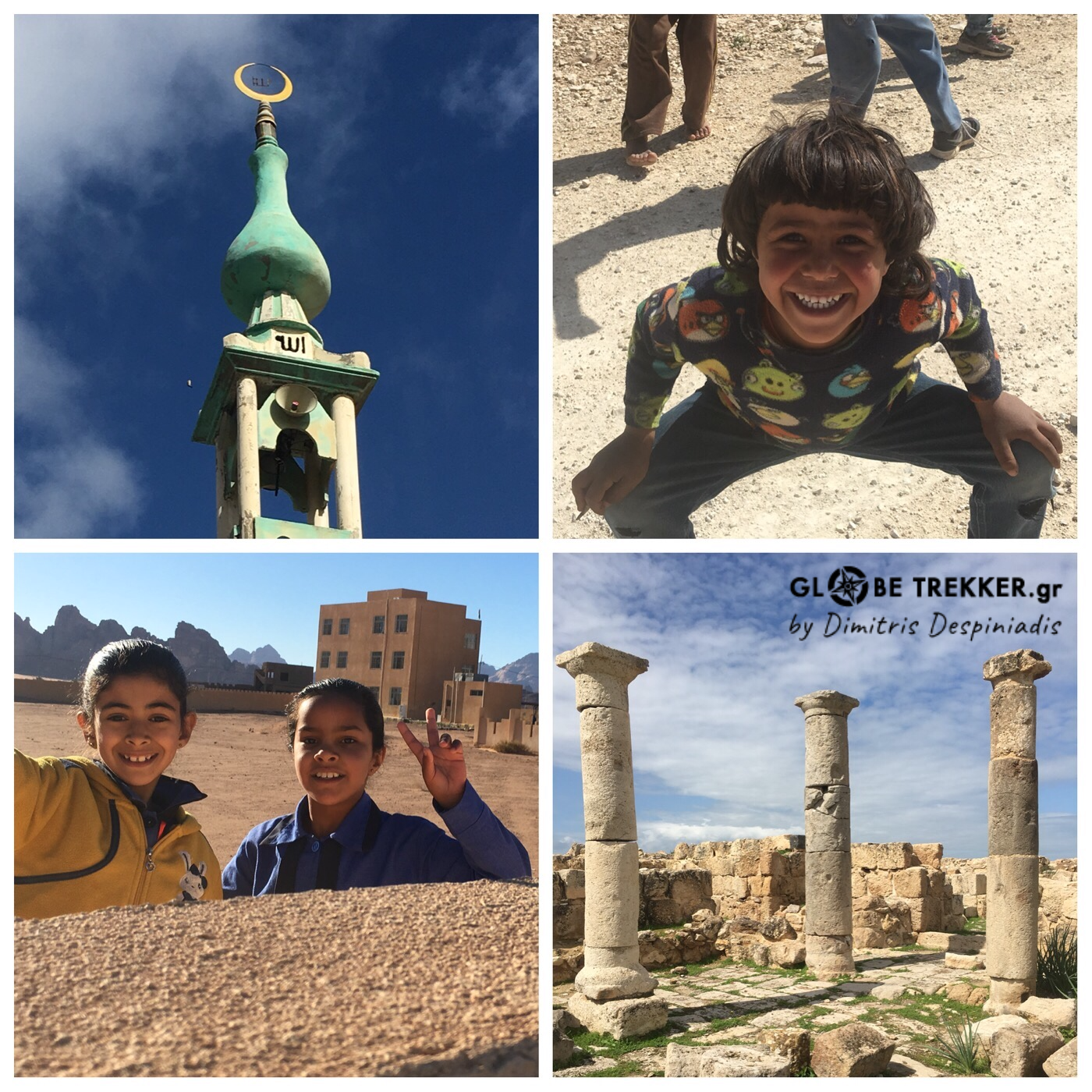
28/02/2018 (excerpt from my diary )
(…) The official route track here in the north is really bad and with no logic at all, leading us often through plowed fields, that have turned into endless mud traps after the recent heavy rains. Markings and maps do not exist at all for the entire route, so we have to get used to moving on with the GPS always at hand. Today was a lengthy day since we got lost and walked quite a bit in the dark to stay on schedule.
We arrived at the last village long after the last call of the muezzin for pray, “we swallowed” four falafel each and slept below an old olive tree half a kilometer away from the village . The scenery may not have impressed us so far, but people really did, so we have high spirits as we know that progressively the scenery will get better and better !
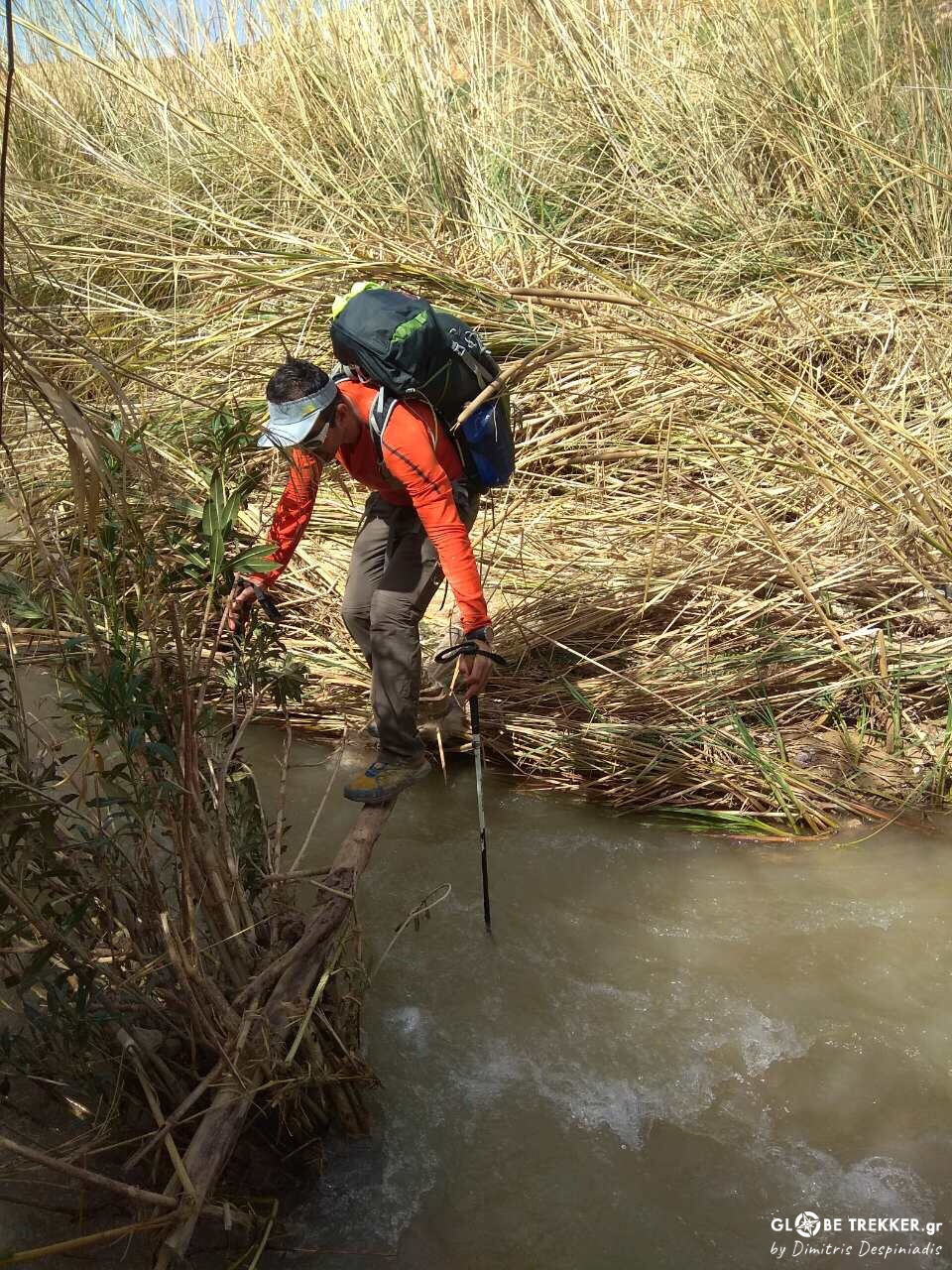
The Dead Sea Canyons
At the southern edge of the Jordan Valley, the scenery changed immensely ! Hills suddenly became barren and colorless and pretty soon we gained a panoramic view of the Dead Sea, the lowest point on Earth (-420m). It was an oxymoron that we were gazing at it from above while standing ourselves a few tens of meters below sea level.
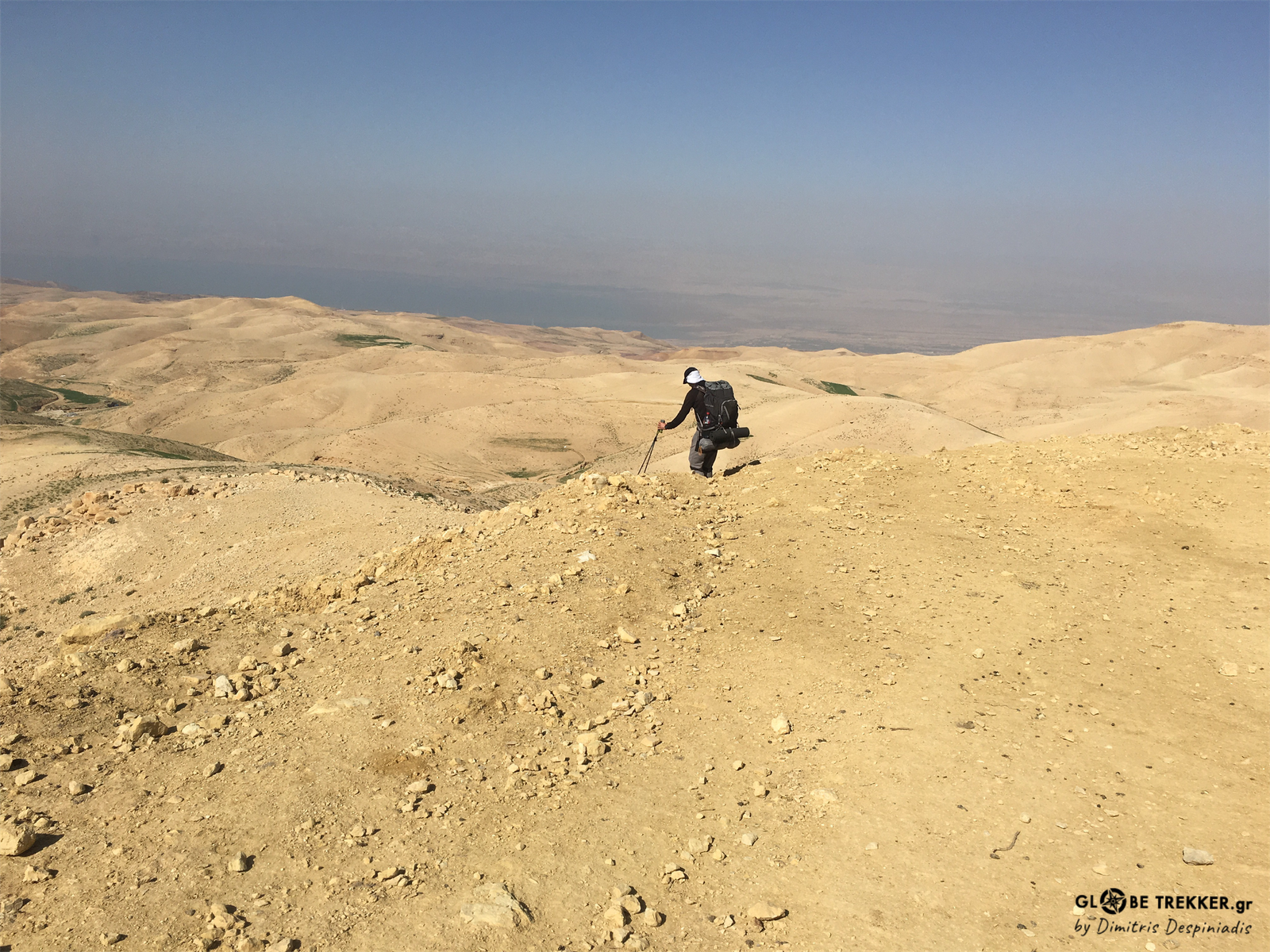
In front of us now were lying the great canyons (Wadis) of the Dead Sea (Hidan and Mujib) that we had to cross, as both are running east to west. And we crossed them both … in one day!
The landscape here is characterized by deep ravines. Due to the dramatic altitude difference and water flow throughout the year, the above canyons – despite their barren image – preserve a surprisingly rich variety of life.
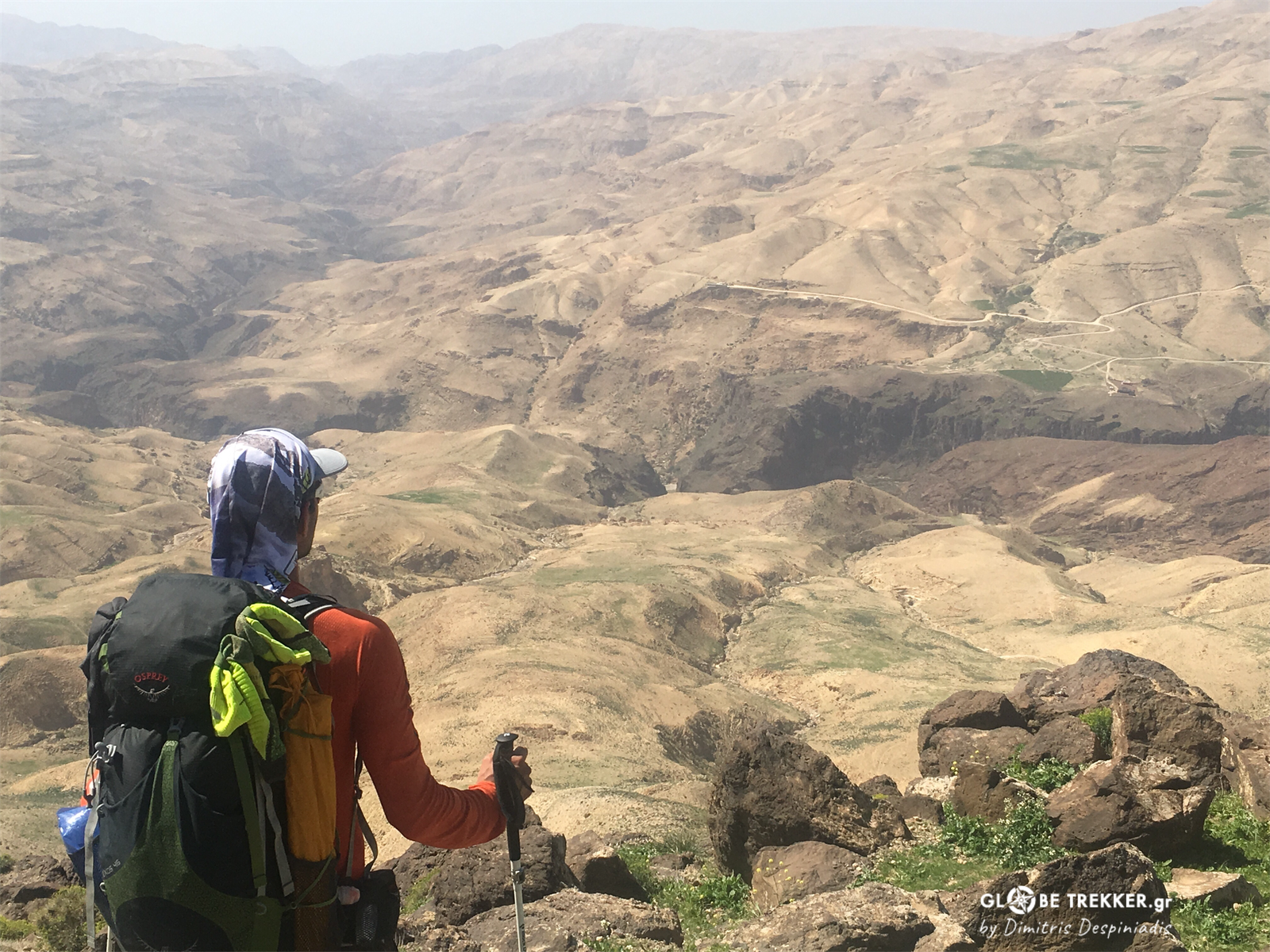
The heat was intense in Wādī Hidan from pretty early in the morning and made the whole process of the long-awaited exit from it by midday exhaustive. Finally we reached a peak and then crossed a fertile plateau towards the wonderful Wadi Mujib.
What a spectacle! Although I was fortunate to find myself in much deeper canyons in Peru (3000m +), I have to confess that in the view of Wadi Mujib -also known as the “Grand Canyon of Jordan”- I was so impressed that I took my time to admire it from the edge of the plateau.
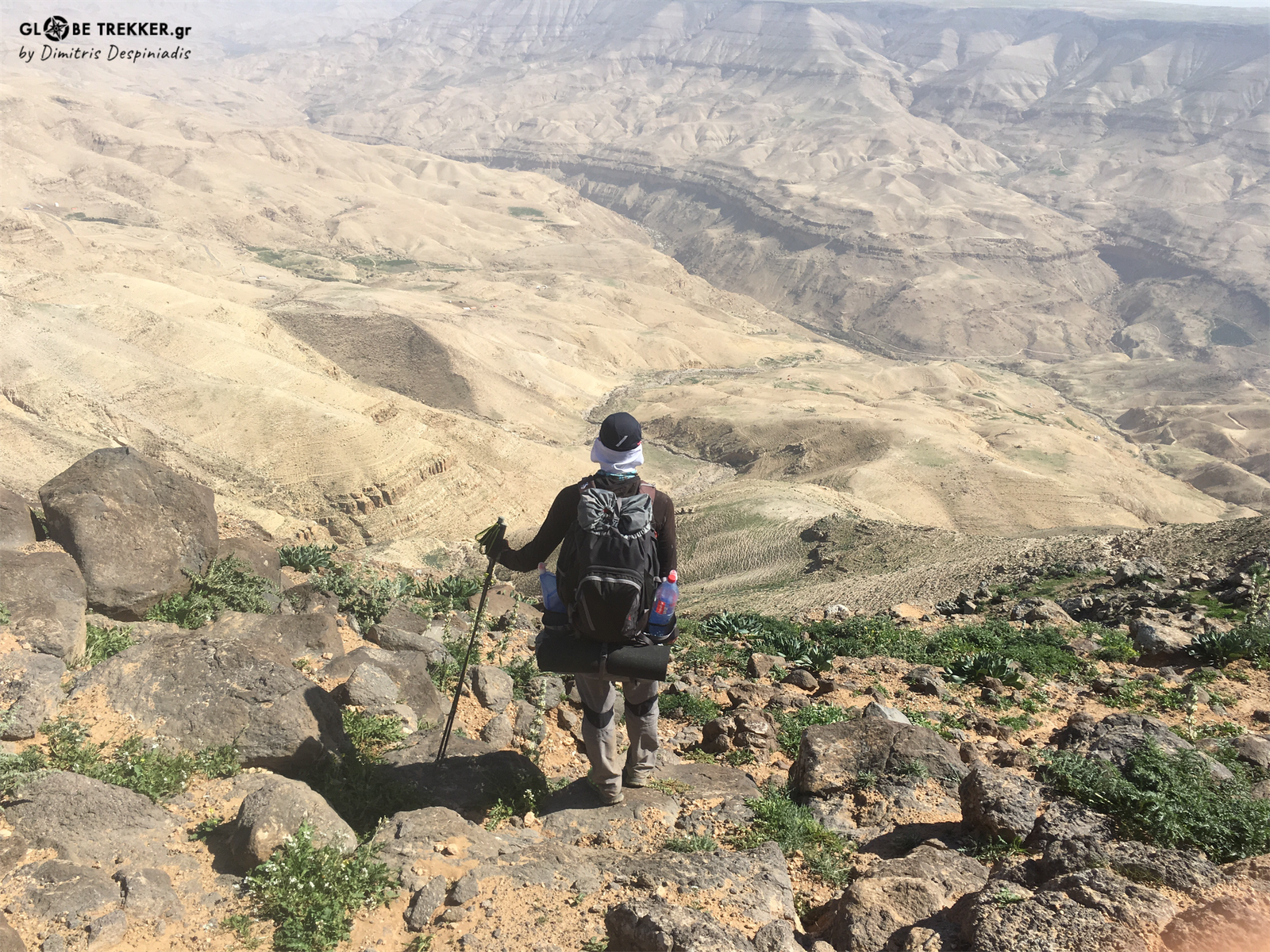
We quickly descended a steep, rugged and centuries old Bedouin path and just before the river we took a break and shared the shade of a cave with a very kind young shepherd!
The ascent that followed was even longer and more tiring than the previous one. Regardless of how plentiful water we drank (and surely more than any other day) we were dehydrated. At dusk -when we camped high up on a balcony- our clothes were completely covered with salts!
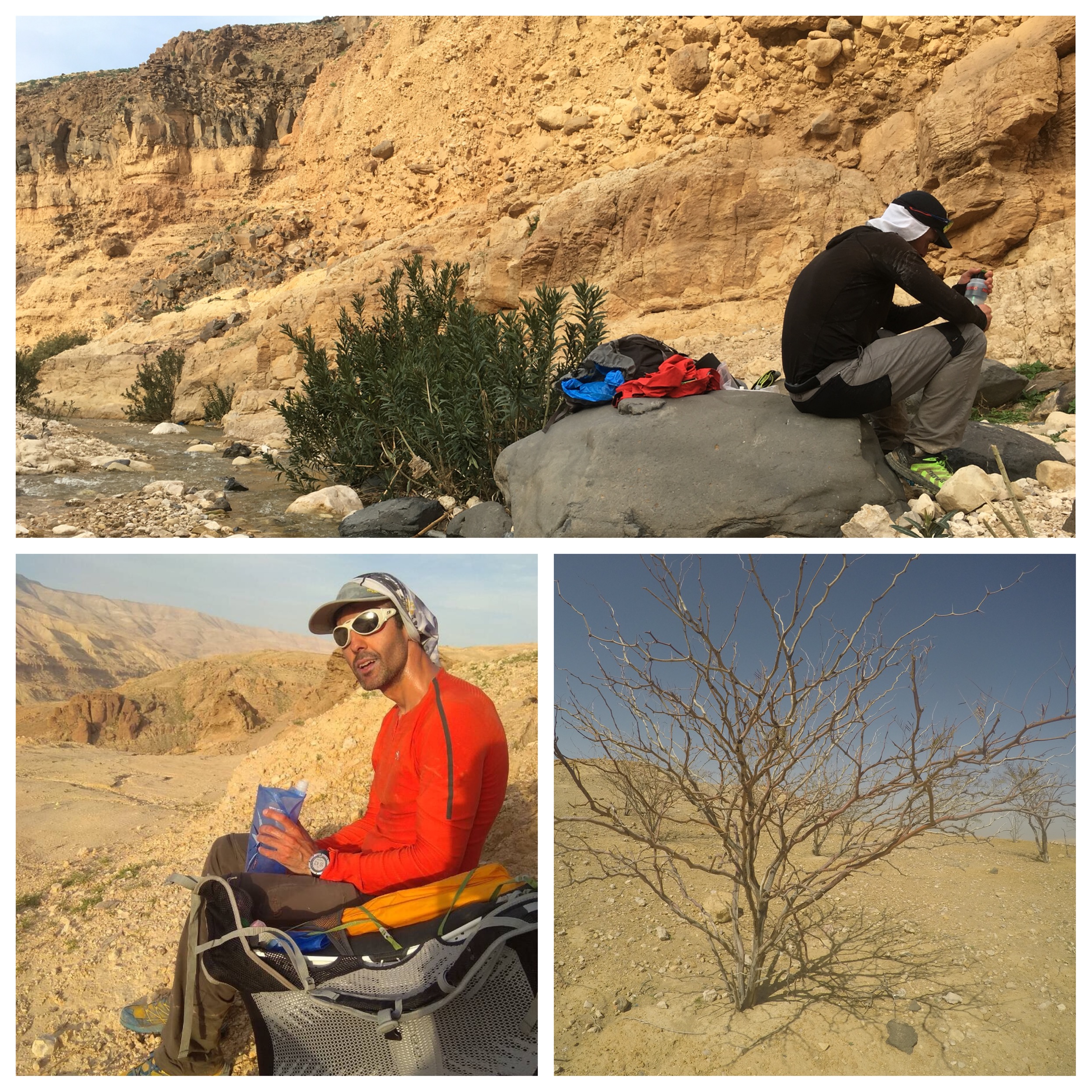
In the town of Karak, whose medieval castle was one of the most important structures of the Crusaders in the Middle East, we had our first refreshing bath after 8 days and replenished our food supplies with plenty of halva and Arab pies!
Unfortunately, we suffered a mild food poisoning there that had an effect on us for the next 24 hours.
At dawn, feeling weak and sleep deprived, we left Karak behind.
After a lengthy traverse along the ridge that overlooks the Dead Sea’s southern boundary, we traversed another impressive canyon (Wādī Hasa ~1000m deep) and camped just before the exit.
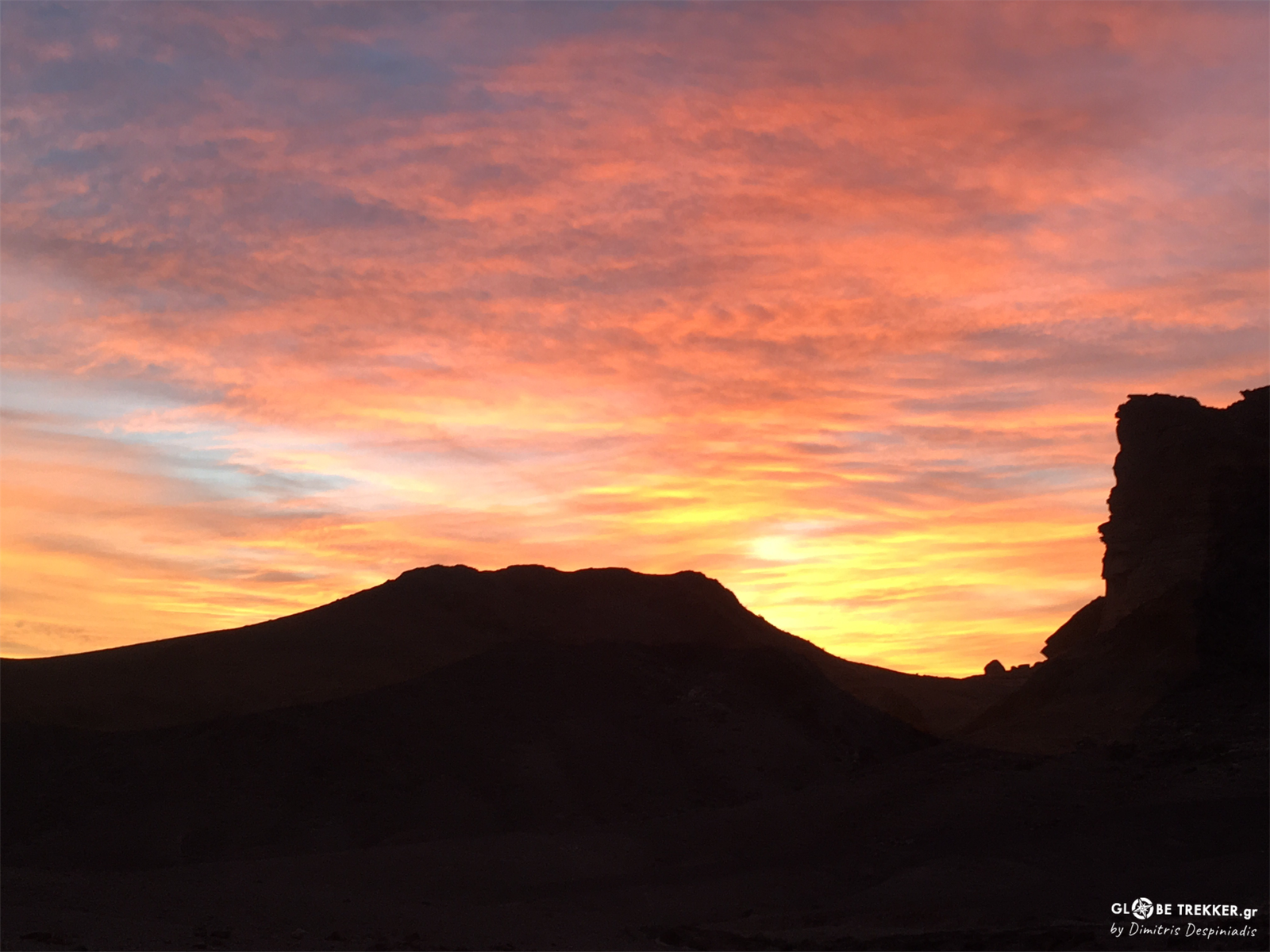
We had already crossed half the length of the country, but the only thing I remember was how tired I was feeling and how much I wanted to sleep!
The insufficient nutrition and especially hydration of the last few days were starting to noticeably affect my performance ( perhaps for the first time at that extent ), something that I should pay more attention from now on ! Argyris was definitely in a much better shape!
Reaching Petra
The more we were proceeding, the landscape was becoming more arid, the heat more intense and the villages sparser. So each day we were breaking camp before dawn and were on the “trail” half an hour later in order to cover as much ground as we could until 09:00 when the sun was still low. The rest of the day we were walking at such a rate in order to have progress, but without sweating too much, since water was now hard to find.
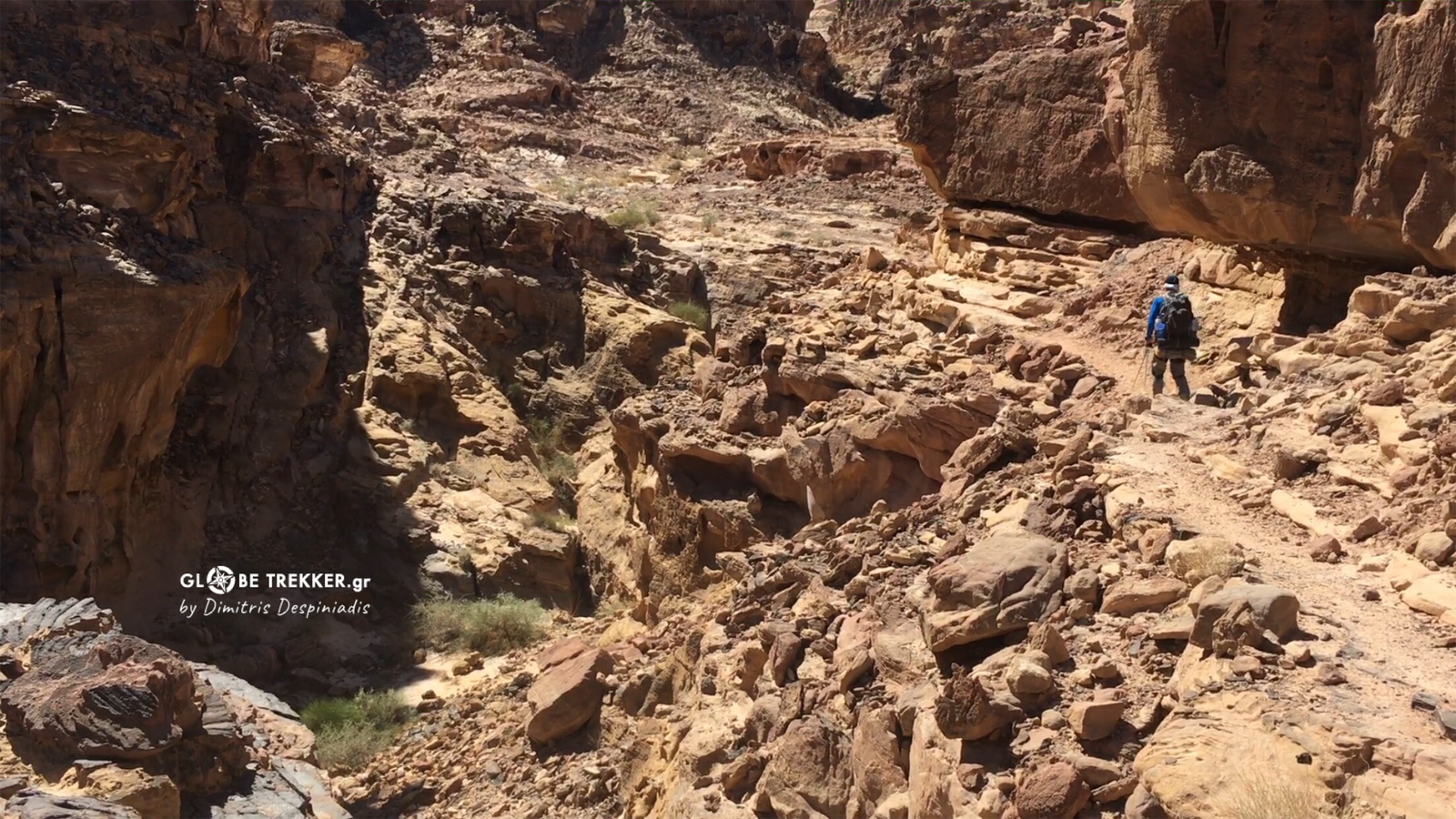
This is how we arrived one afternoon at Dana, a deserted till recently village of the Ottoman period perched on a cliff. Dana regained life in recent years due to the state’s organized effort to attract nature lovers, whom I have to admit that in ALL (!) our journey we did not see a single one !
07/03 (excerpt from my diary )
Everything was silent and still as we left the village at dawn. The sun’s rays did not take long to penetrate the depths of Dana valley.
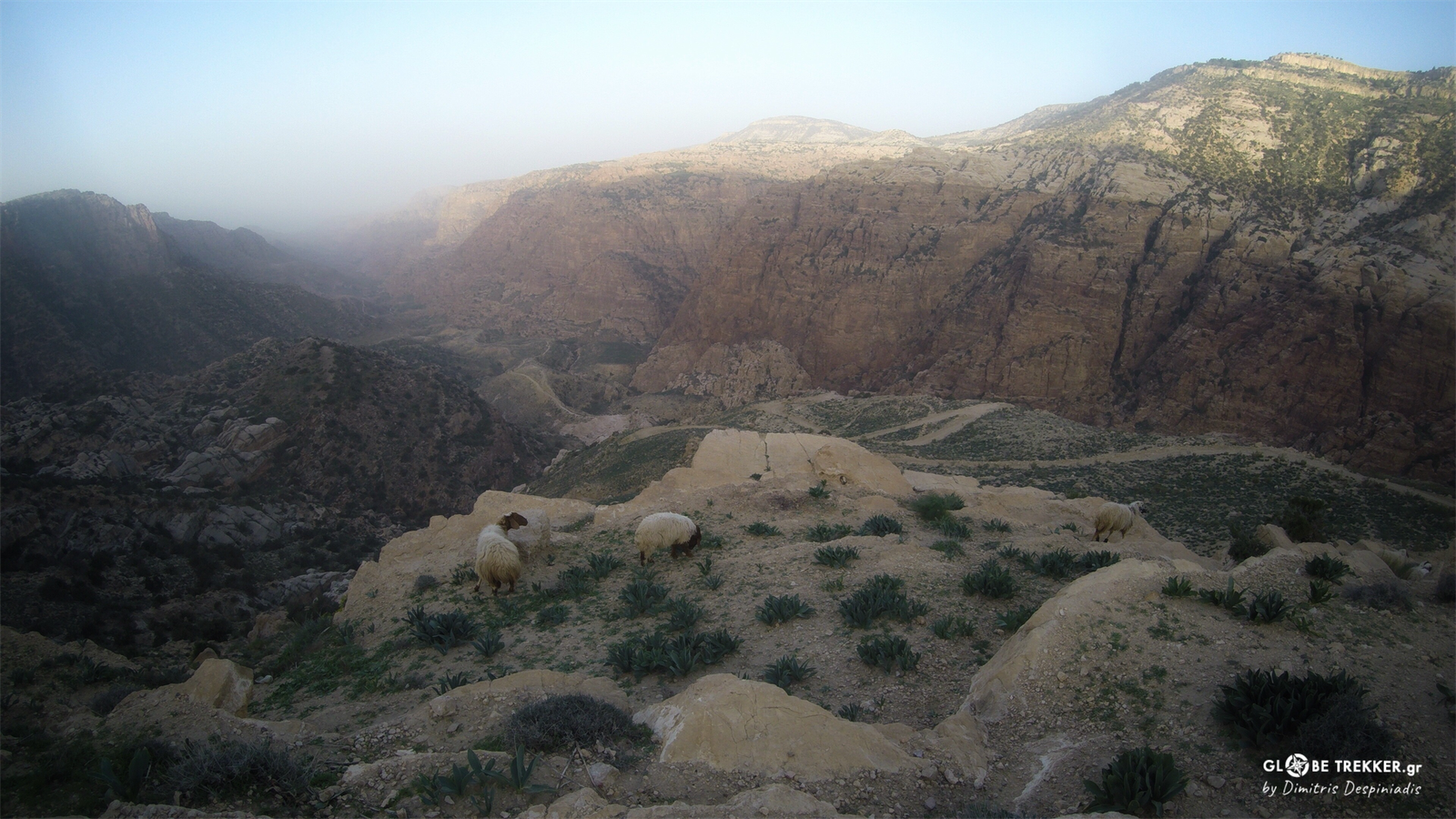
For the rest of today’s particularly hot day, we marched through various climatic zones within the country’s largest Nature Reserve that ranges from the northern rift valley all the way to the deserts found north of Petra.
After the gorge and the ancient Feynan mines – which in the Roman era were the heart of copper mining operations in the area – we found our way through a “labyrinth” of wild mountains and a sequence of ravines filled with dark sun baked stones and really old fossils of marine life.
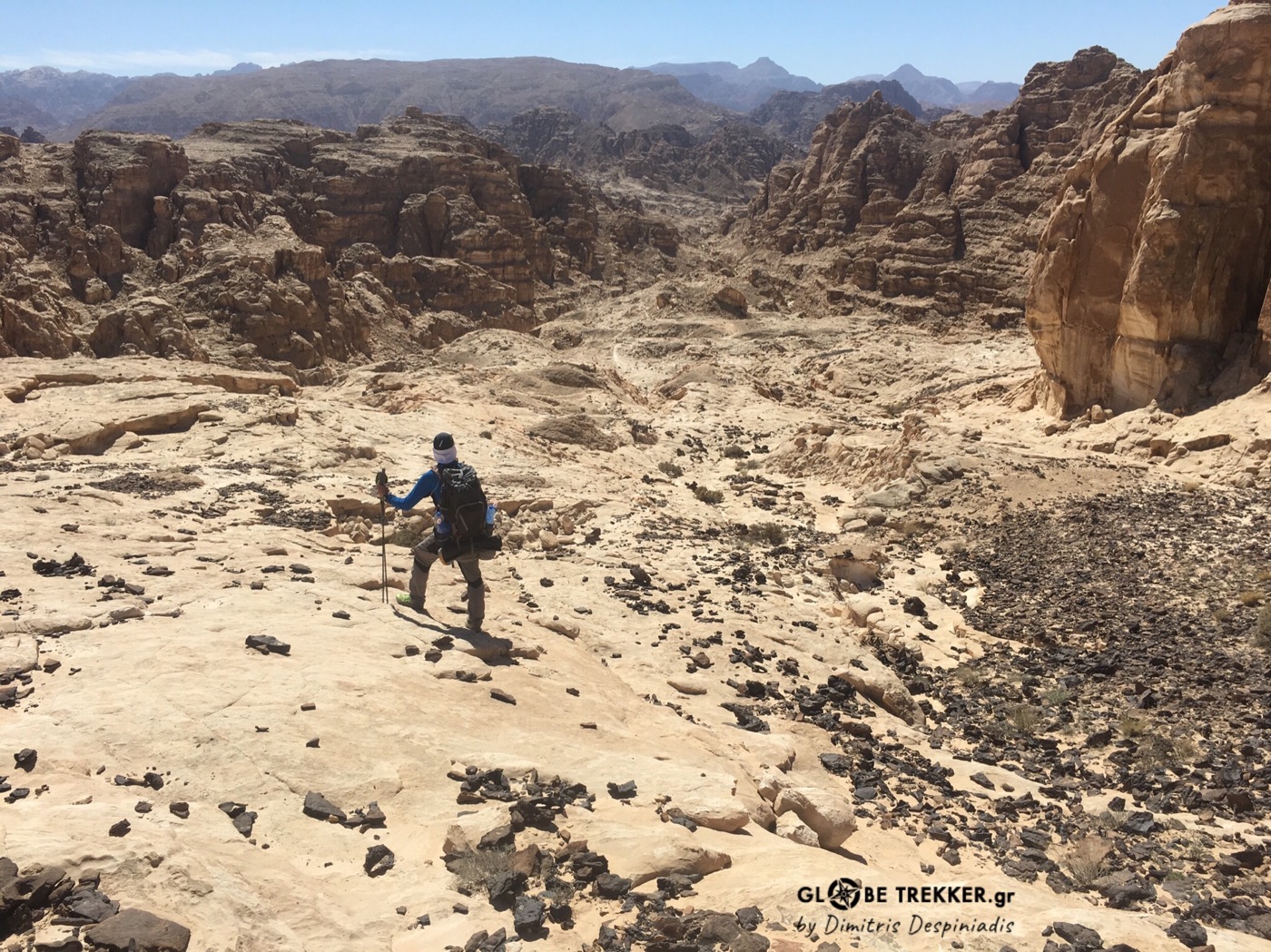
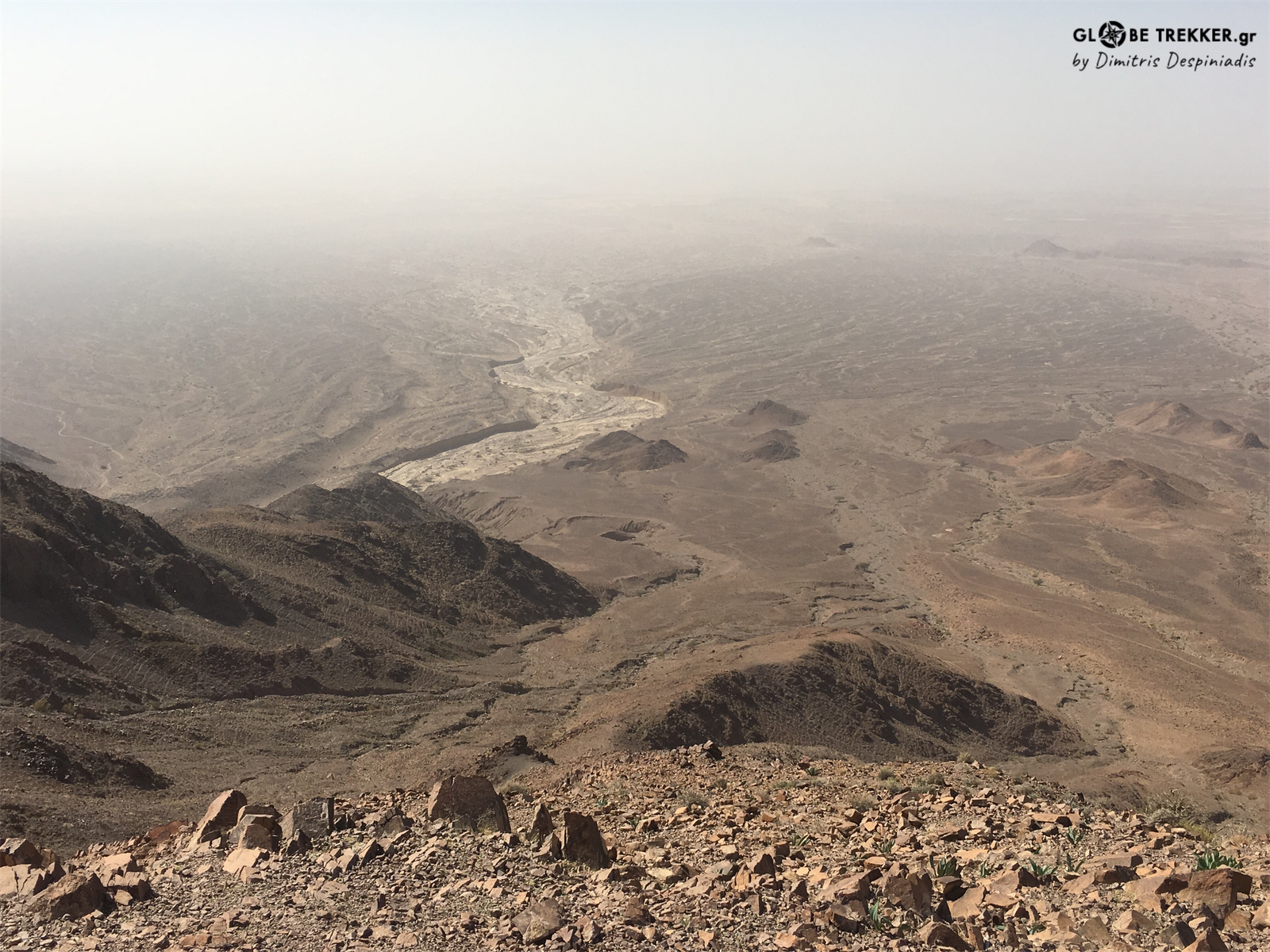
We set up camp beside the cliffs, as the sun was disappearing behind the neighboring mountains!
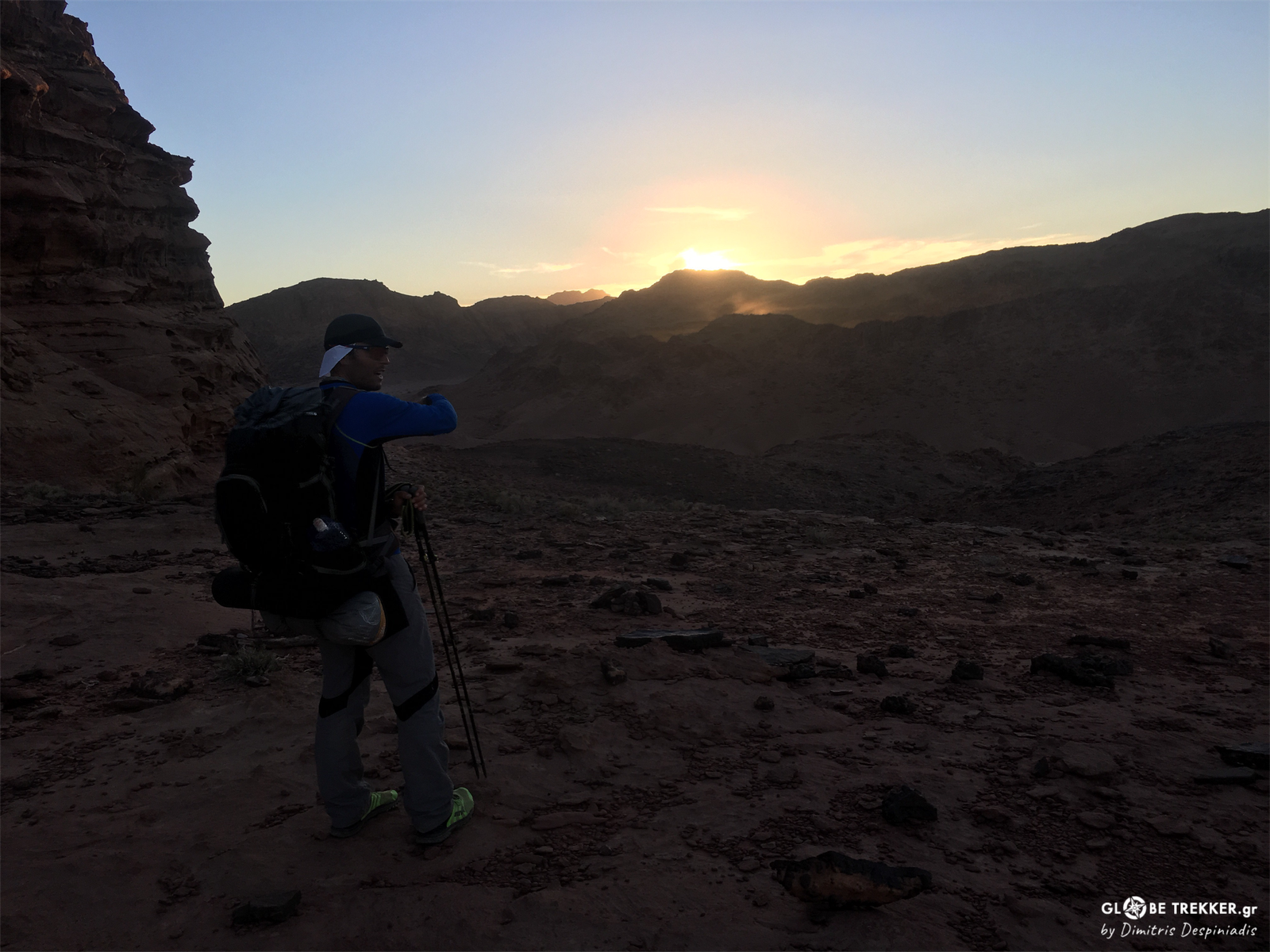
The next day we traveled along the escarpment with its interesting sandstone formations till we reached the fabled Petra, an ancient city carved literally on the rocks by the Nabataeans, an Arabic tribe that in its era controlled the trade routes from Damascus to the Red Sea and from the Arabian desert to Sinai.
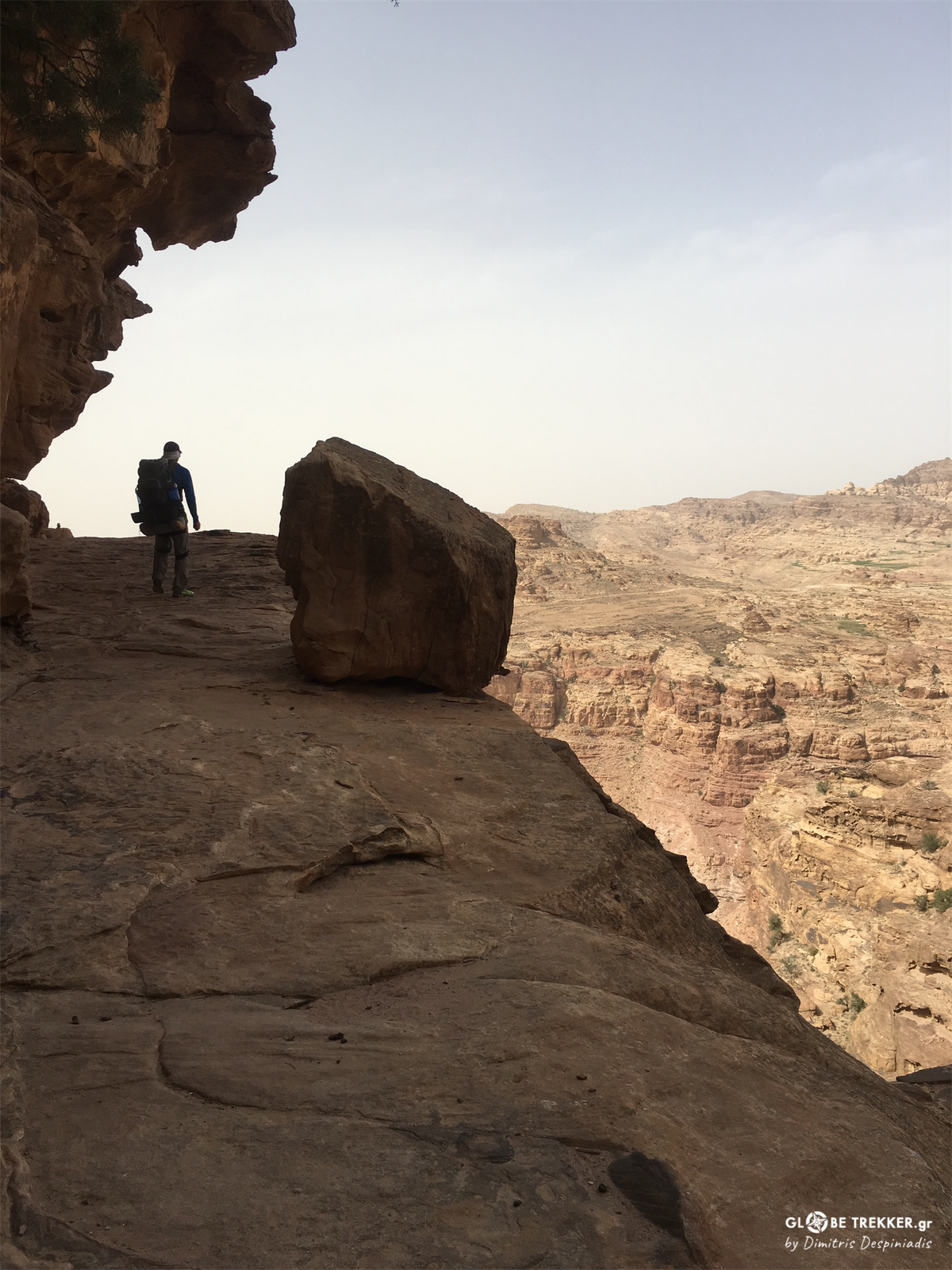
We reached this world class archaeological site “unconventional” from its northwestern corner (unlike 99% of its visitors) and did not encounter a single soul other than a flock of goats until we stood in front of the famous “Monastery”, an elaborate facade 50 meter high carved on the rock!
What a great spectacle we were about to witness for the rest of the day!
An entire ancient city carved on the rocks and surrounded by magnificent gorges and mountains!
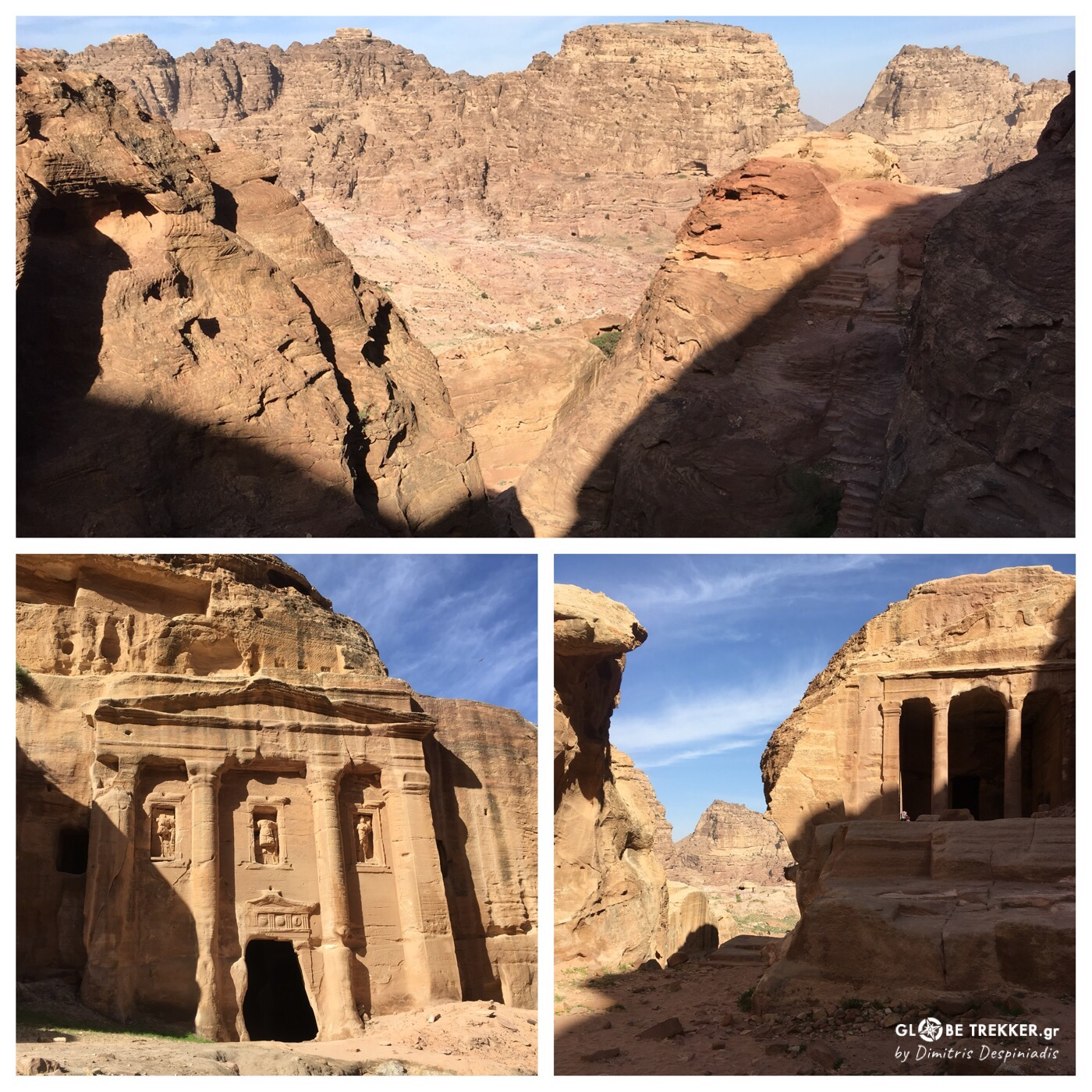
Undoubtedly one of the greatest remaining wanders of the ancient world !
It is estimated that Petra, at the peak of its era, had been inhabited by 30.000 people . The Nabateans were giving great importance to the afterlife and nearly all the living masterpieces found on the site are tombs. On contrary, their own “ephemeral” residences were totally destroyed.
Equally impressive was its pioneering hydrological system, consisting of dams and pipelines for collecting and transporting rainwater and spring water.

We descended the 800 steps that separated us from the main tourist trail of the archaeological site and mixed with the hordes of tourists ( many of them dressed like “Indiana Jones”). As we passed from numerous stalls, we noticed that vendors were watching our big backpacks curiously and didn’t bother to try selling us a souvenir or a camel ride!
The desert
After Petra we went through the most isolated and BY FAR most beautiful part of our whole trip, as it was there that we experienced the solitude and the infinite charm of the desert!

So, by walking through extremely varied desert landscapes, we witnessed the various stages of a continuous process that is taking place for millions of years now, in which water – an element from which these environments are so deprived – and wind are constantly carving the soil and the rocks, giving them different textures, shapes and colors, thus transforming mostly slowly and at times aggressively the landscape .
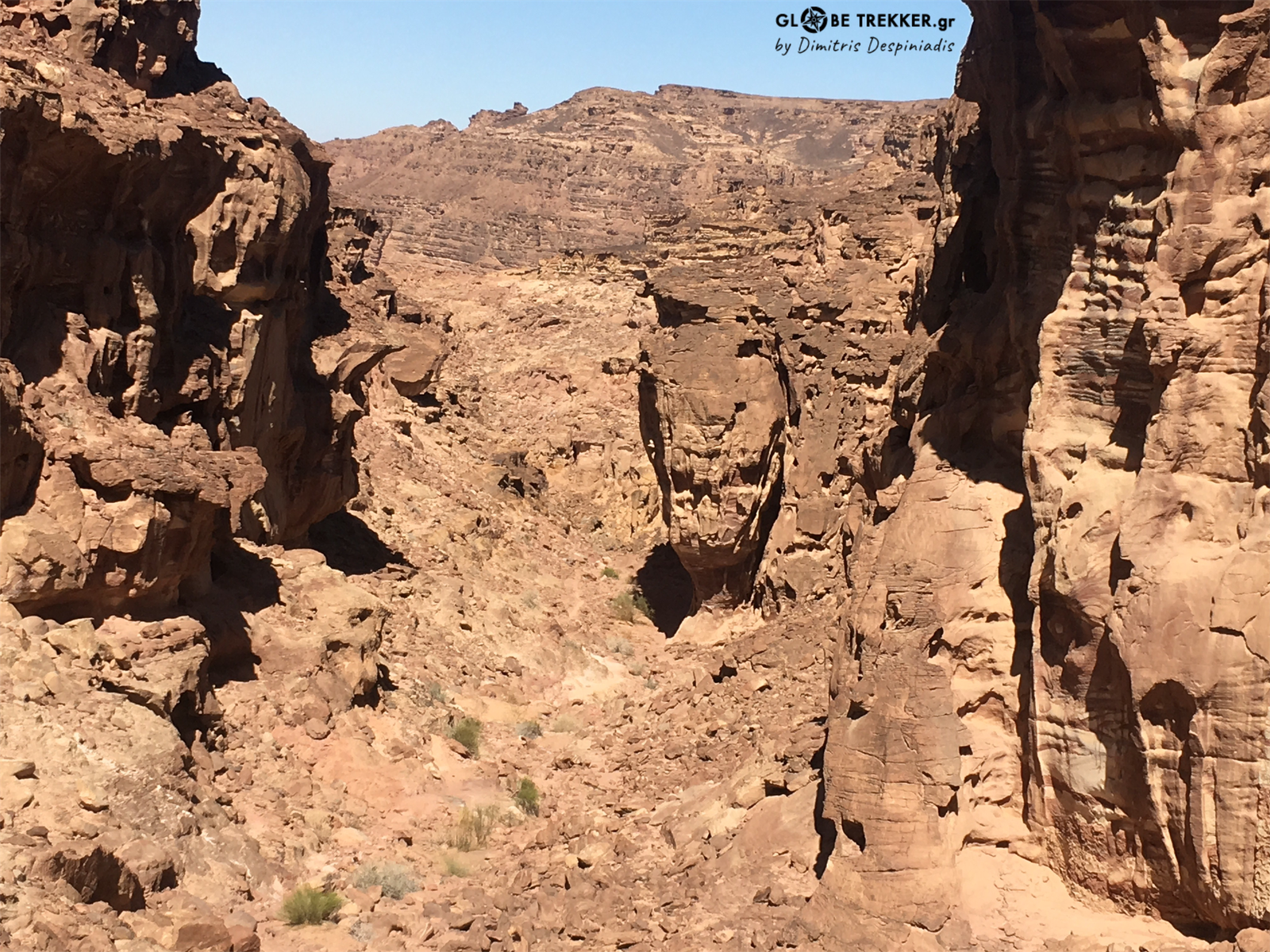
We marched through extremely rough terrain beyond Madusa’s mountains, at times traversing the broken canyon slopes and, wherever that seemed impossible, by crossing their dry riverbeds.


Always keeping in mind how DANGEROUS flash floods are in very narrow gorges, we avoided camping in them completely. In contrary, we slept high on “balconies ” in wider Wadis.
A sudden thunderstorm can send a torrent on such a dry deep channel (Wadi). This torrent cleans the dry and sun-baked earth, taking everything (stones, sediment, etc.) and everyone in its passage.
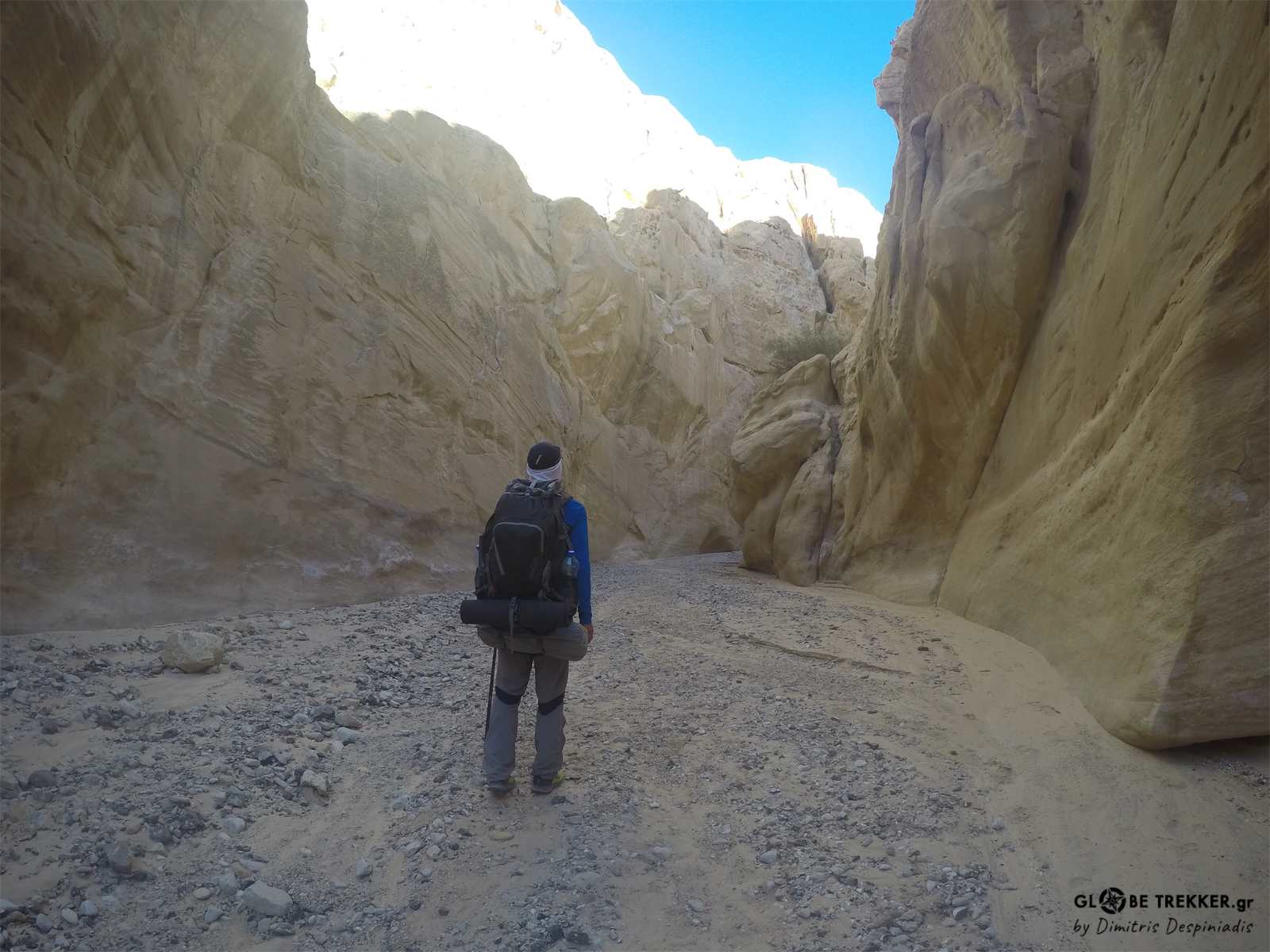
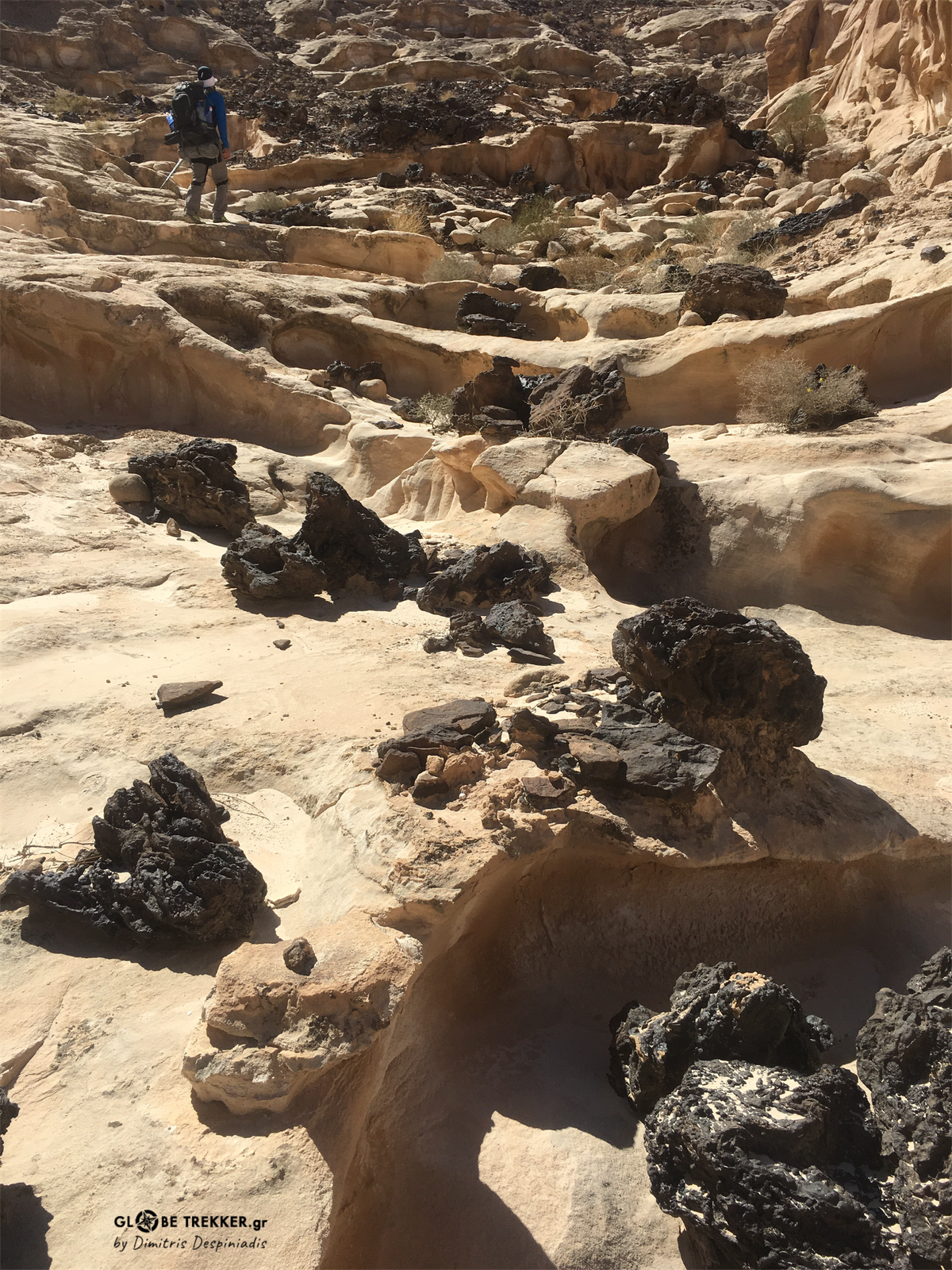
Both the scenery and its silence were otherworldly and cannot be described by words and images. Sandstone was the dominating rock and its color was constantly changing depending the angle that it received the light!
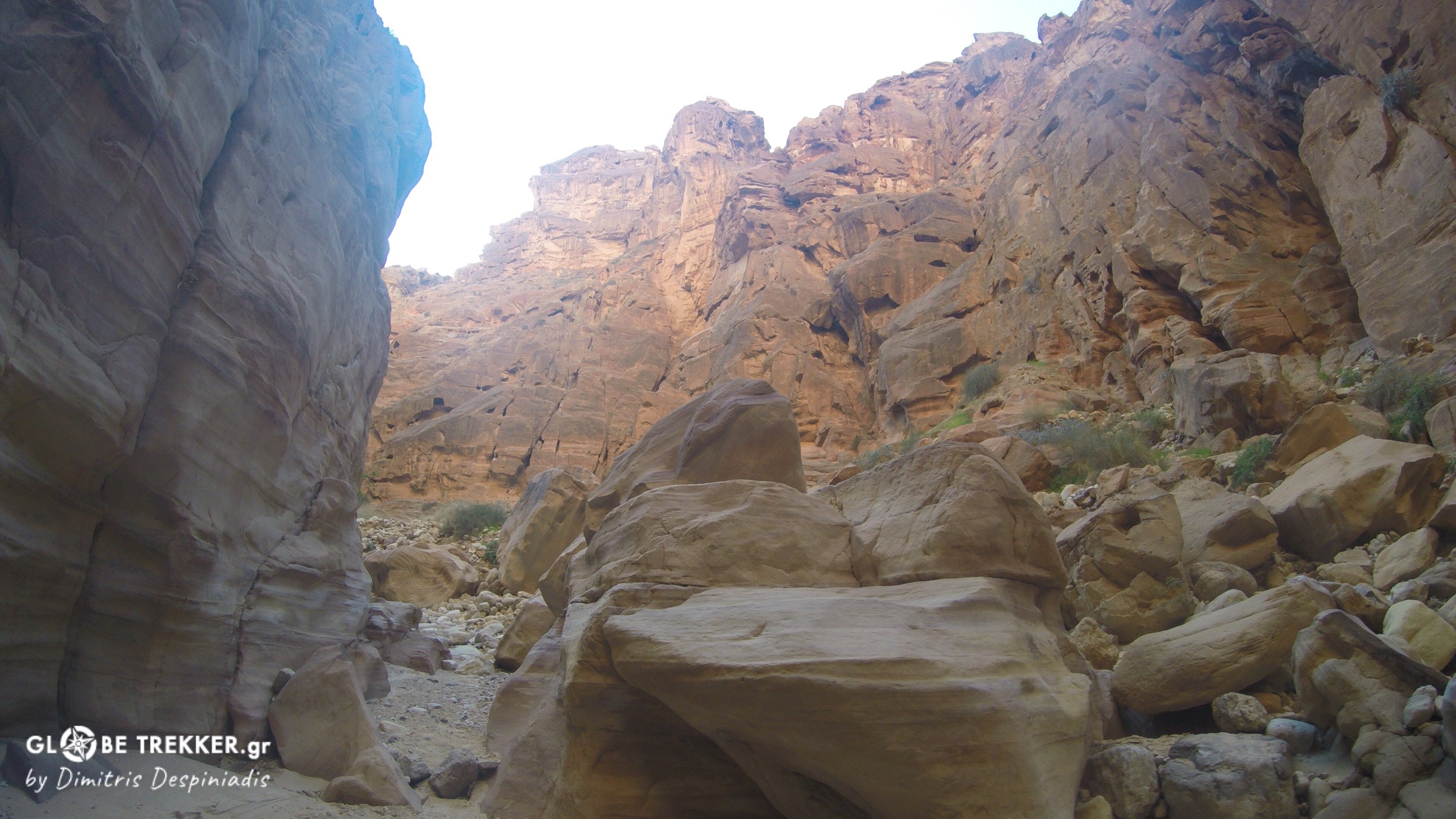
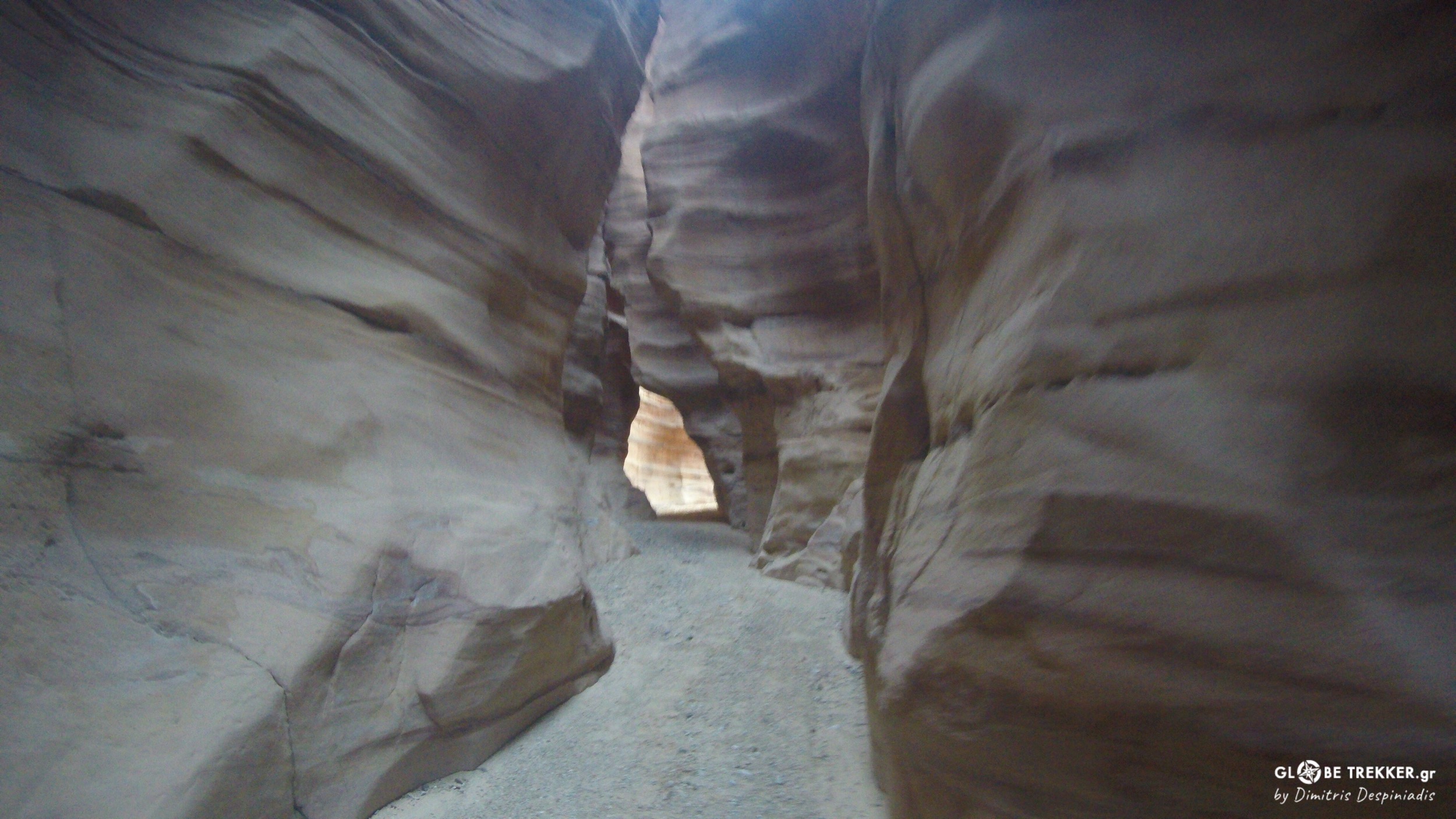
And in the middle of nowhere, after many miles and 2 days of marching , we show again traces of human presence that were no other than a lonely Bedouin camp!
These people are leading a simple yet tough life, struggling every day for what is absolutely necessary for survival. They continue to graze their goats and 2 camels in very poor soils that would seem completely barren to almost anyone!
However here – as in the whole country – we received their generous hospitality, which is so deeply rooted in their tradition!
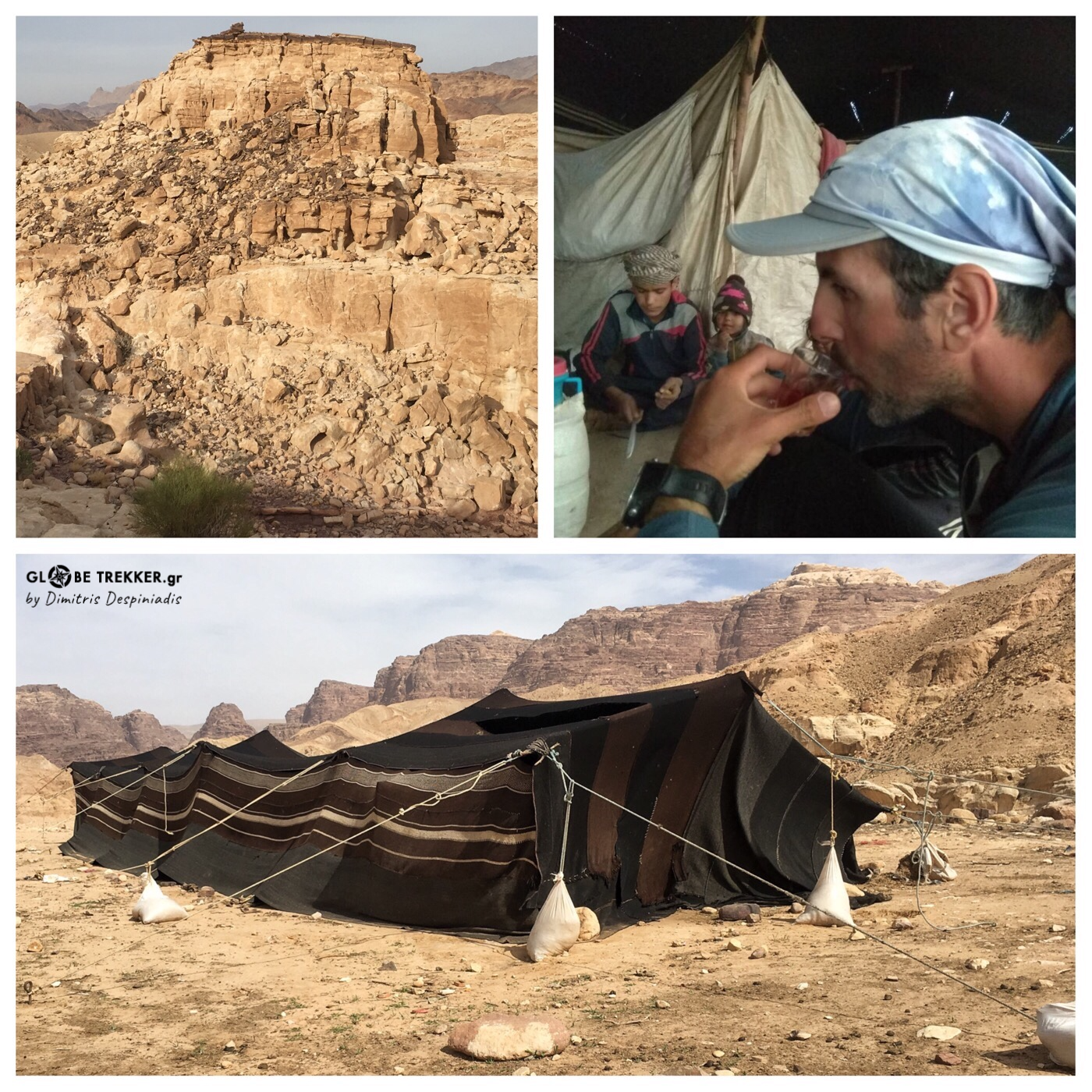
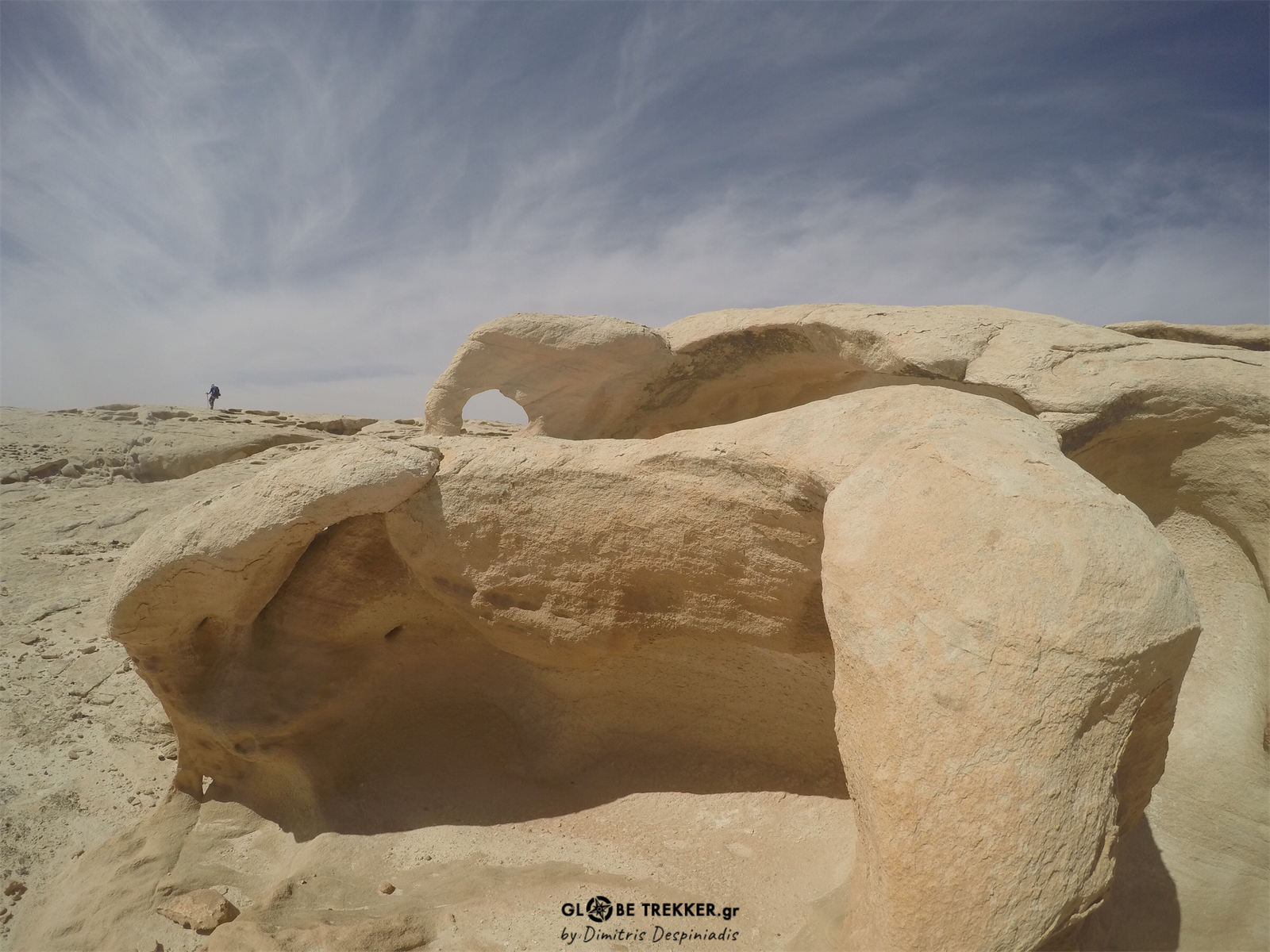
After the tiny hamlet of Abbasiya , the rocky desert turned into sandy.
So, over the next two days, we crossed the famous Wadi Rum, one of the finest desert landscapes found on the planet and widely known in the western world from the descriptions of TE Laurens at the beginning of the previous century!
The blurry Middle Eastern light did not let us admire the scenery around us for the best part of the day.
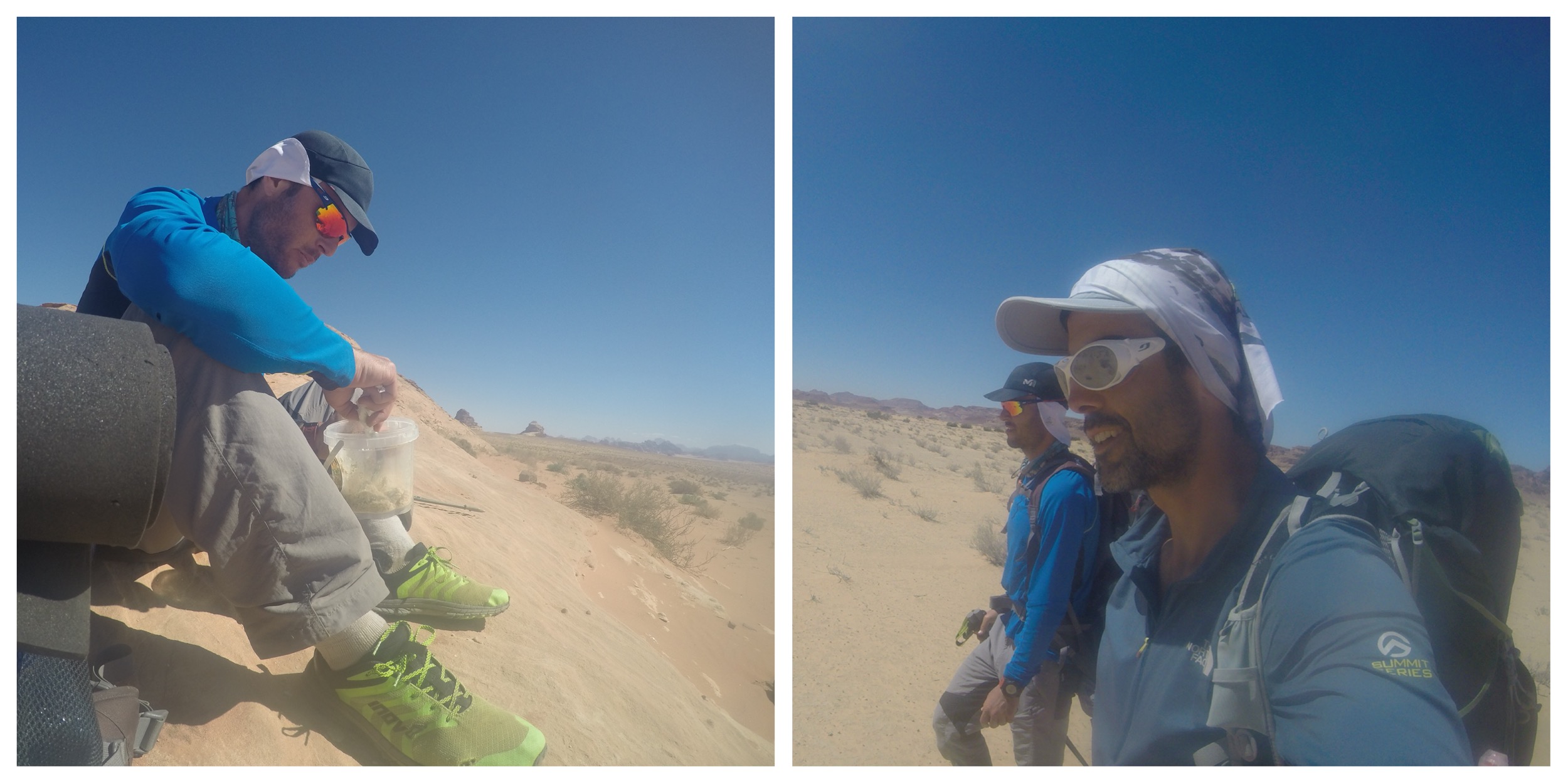
But when the sun was low again, haze retreated completely, and the atmosphere was clear, revealing till the last detail the strange shapes of the scattered sandstone towers that resembled red islands in a sea of sand!
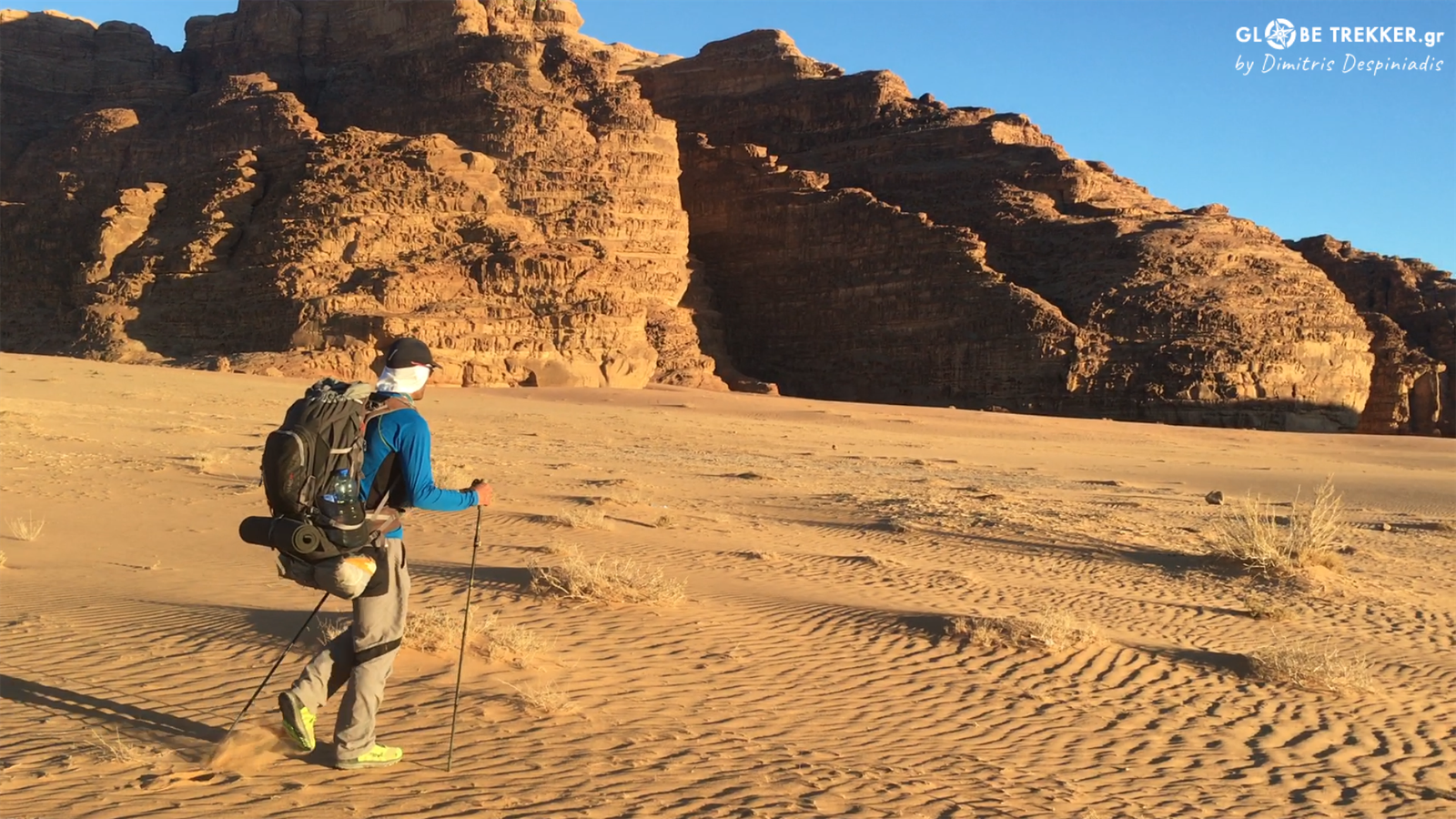
It was a really wonderful feeling to walk in the golden-orange sand during the “golden hour” with its pure light !
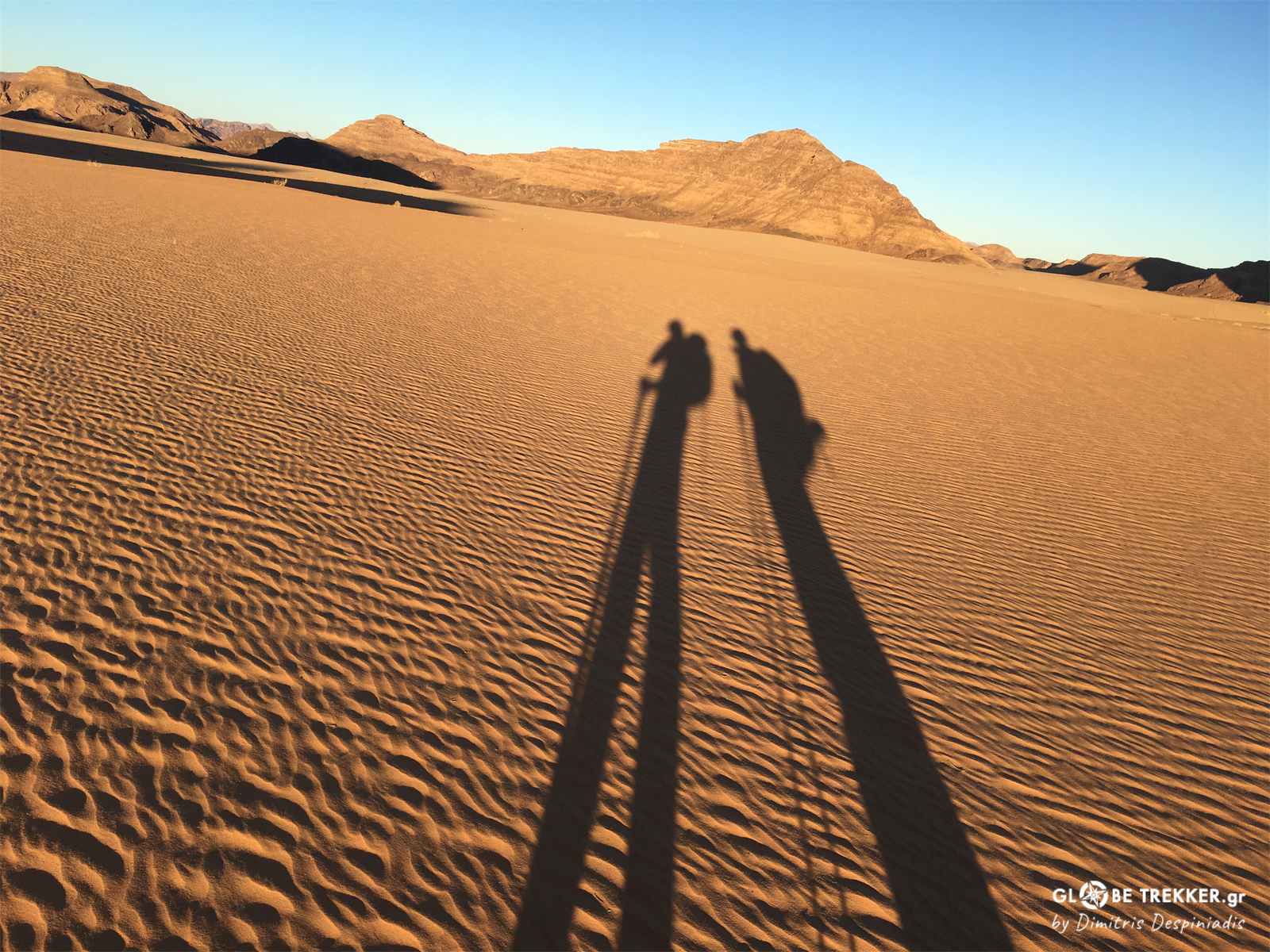
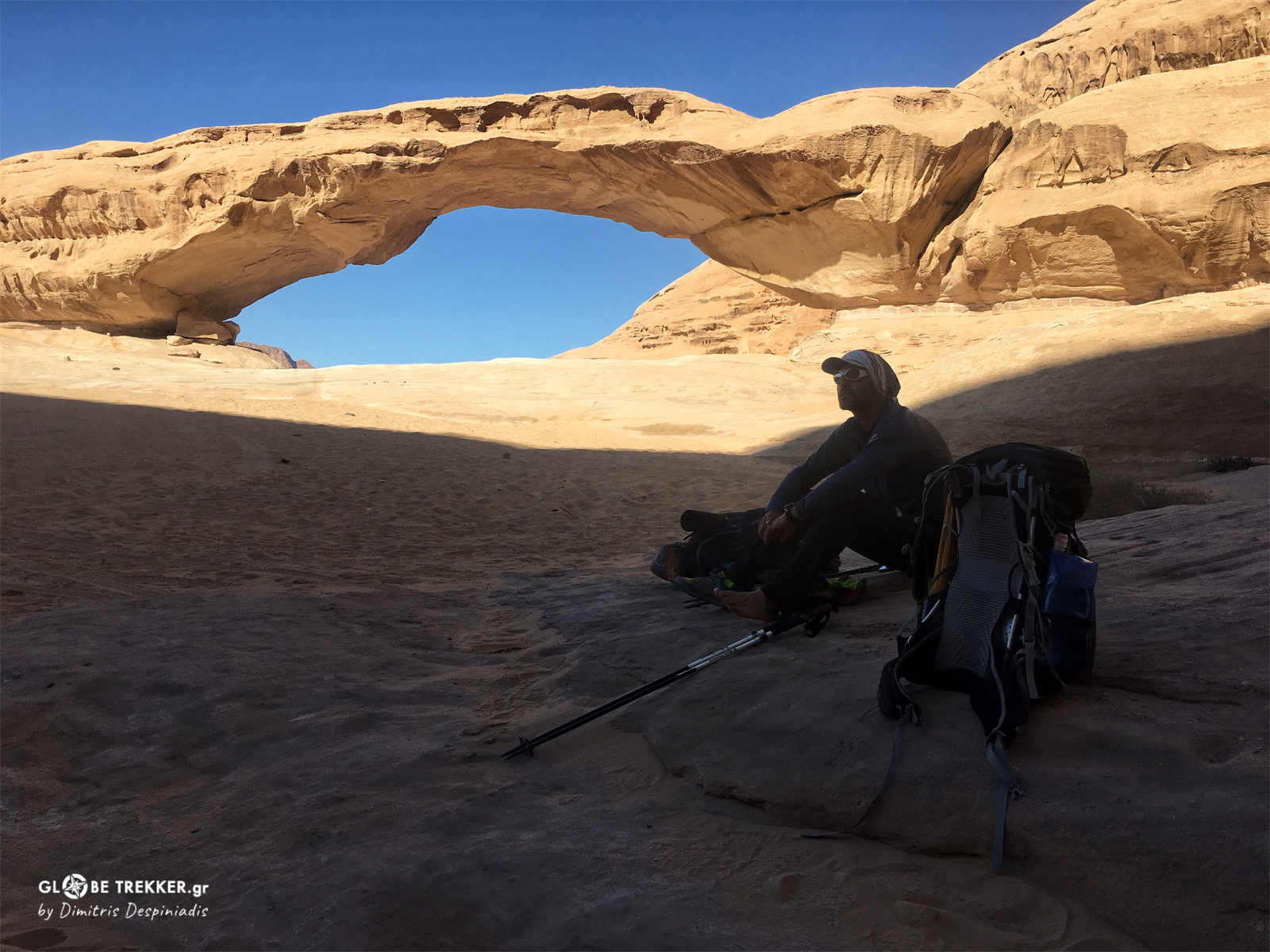

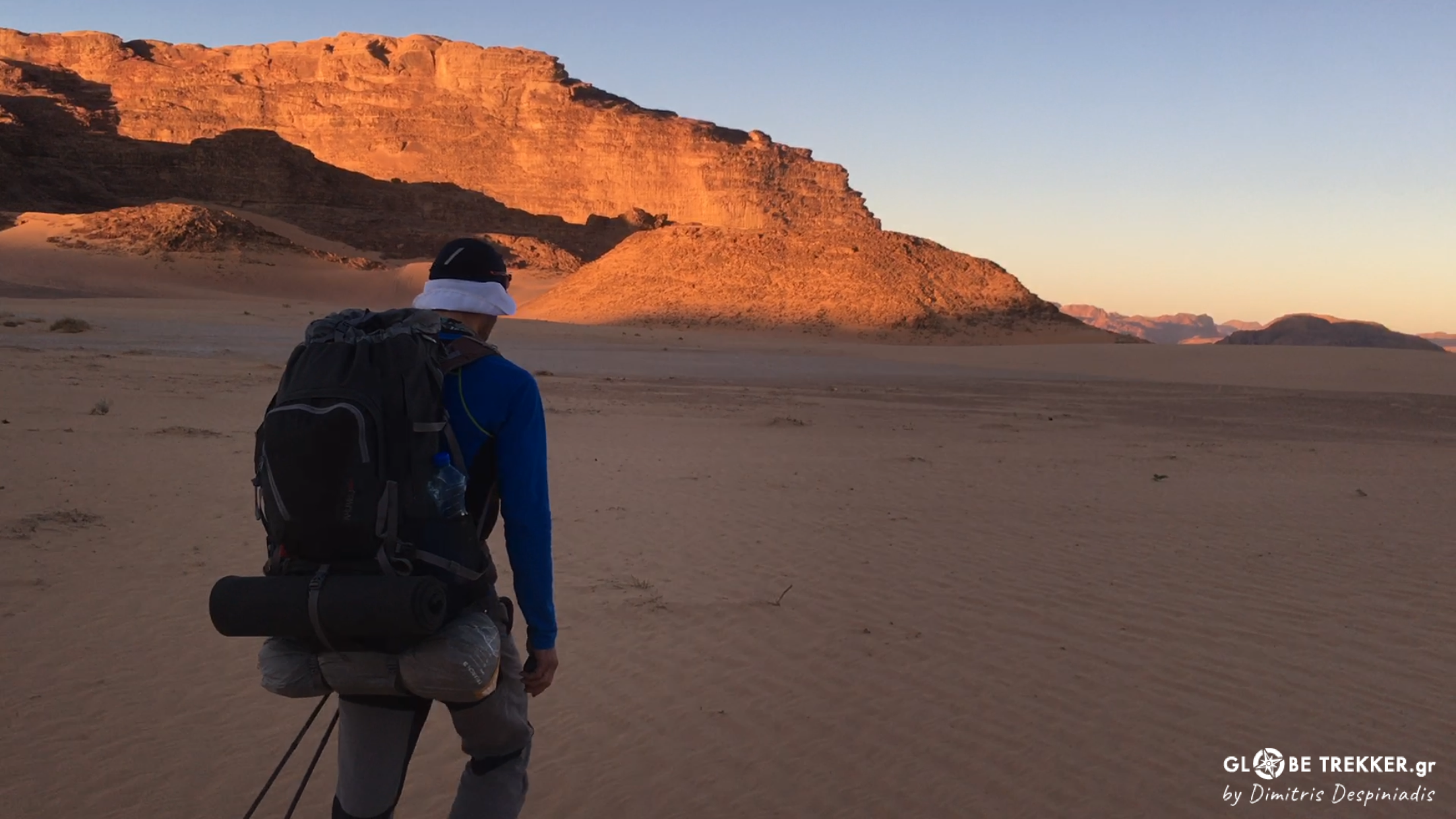
With less than 50 kilometers away from the Red Sea and the end of our long walk, we set up camp at a beautiful spot on the southern edge of Wadi Rum, enjoying the cooling of the heat and the slow transition of the “fiery” red rocky columns of the desert into black !
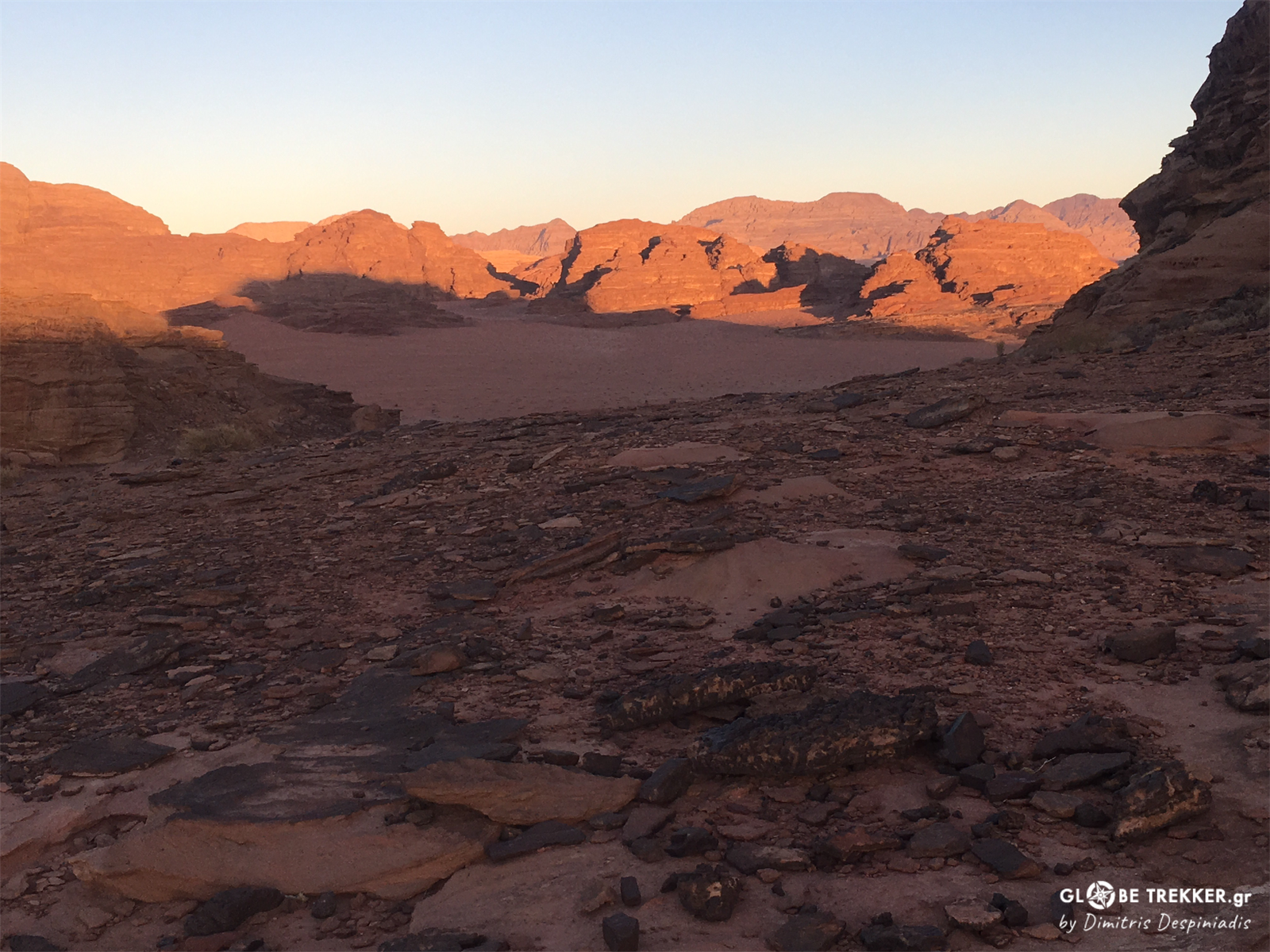
This last night everything was still and the sky full of countless bright stars. Magic!
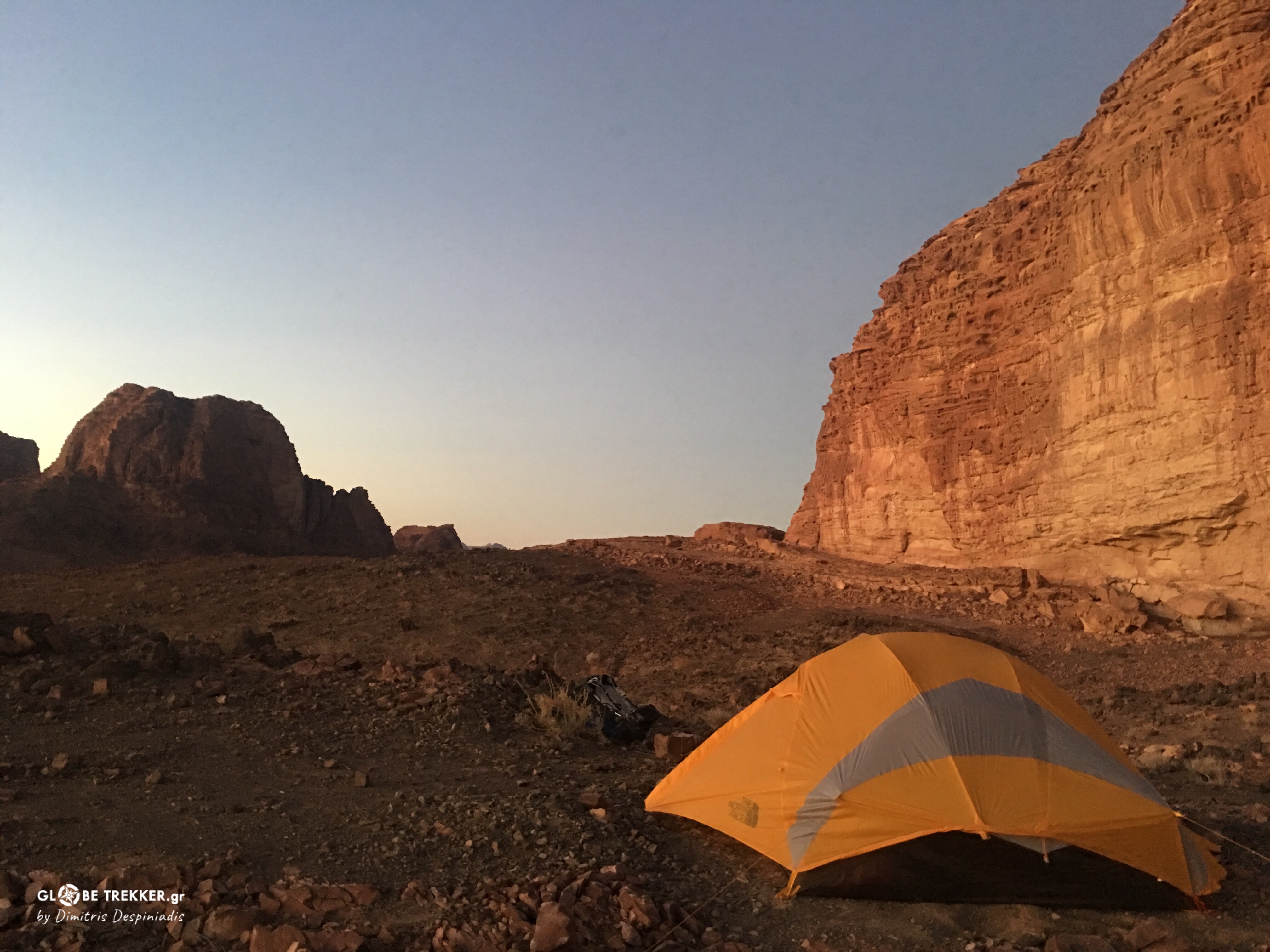
On the 16th and last day we passed from the former Saudi Arabian Titen, the last – and certainly forgotten – settlement (20 inhabitants) of our trip, which became Jordanian as part of a deal in which Jordan exchanged 6000 square kilometers of its desert for 18 km of coastline.
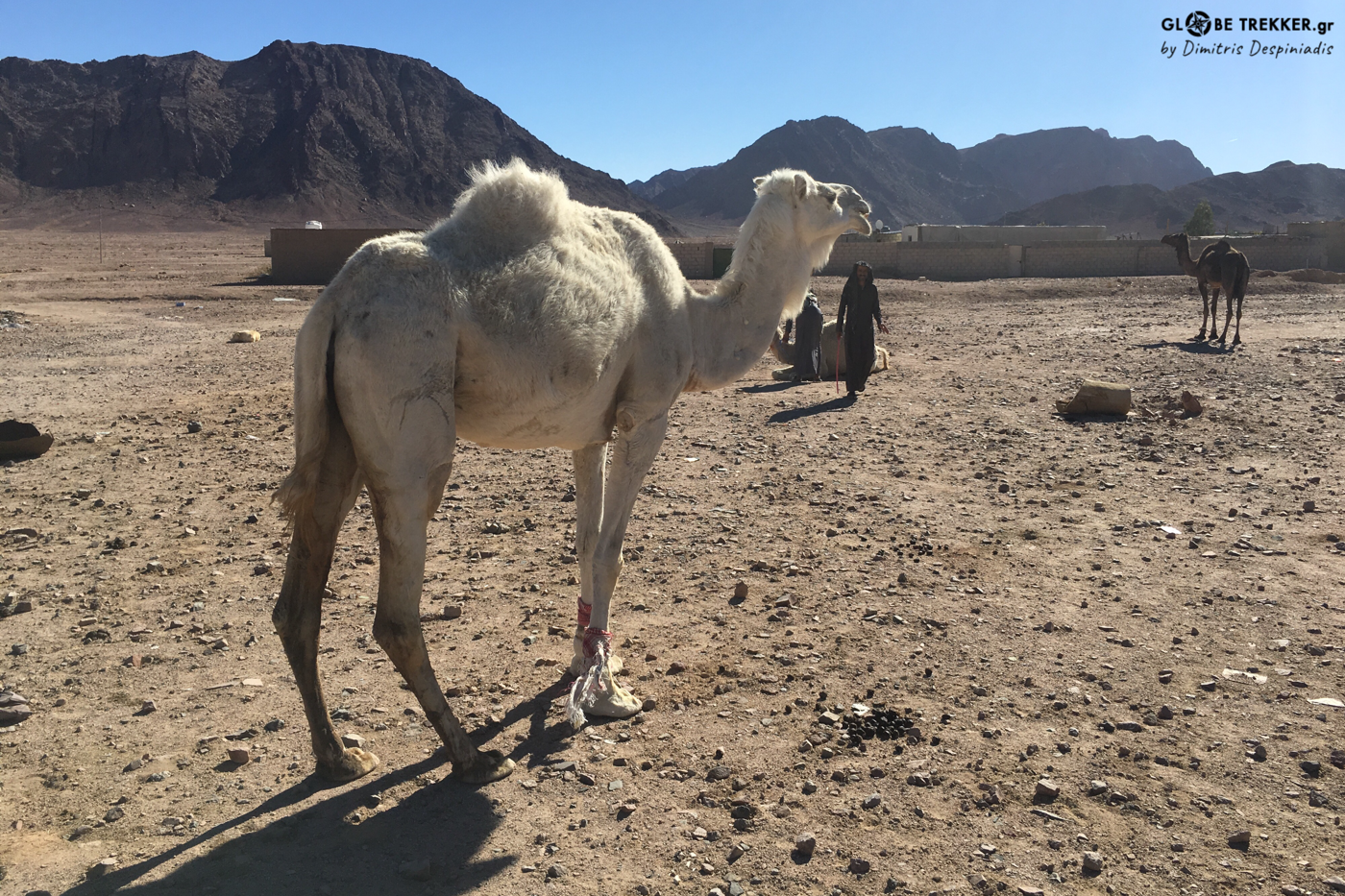
From Titen, we followed old goat paths towards west and the last barrier of desert mountains. At the last pass for the first time we gained view of the gulf of Aqaba and beyond that the mountains of Sinai.
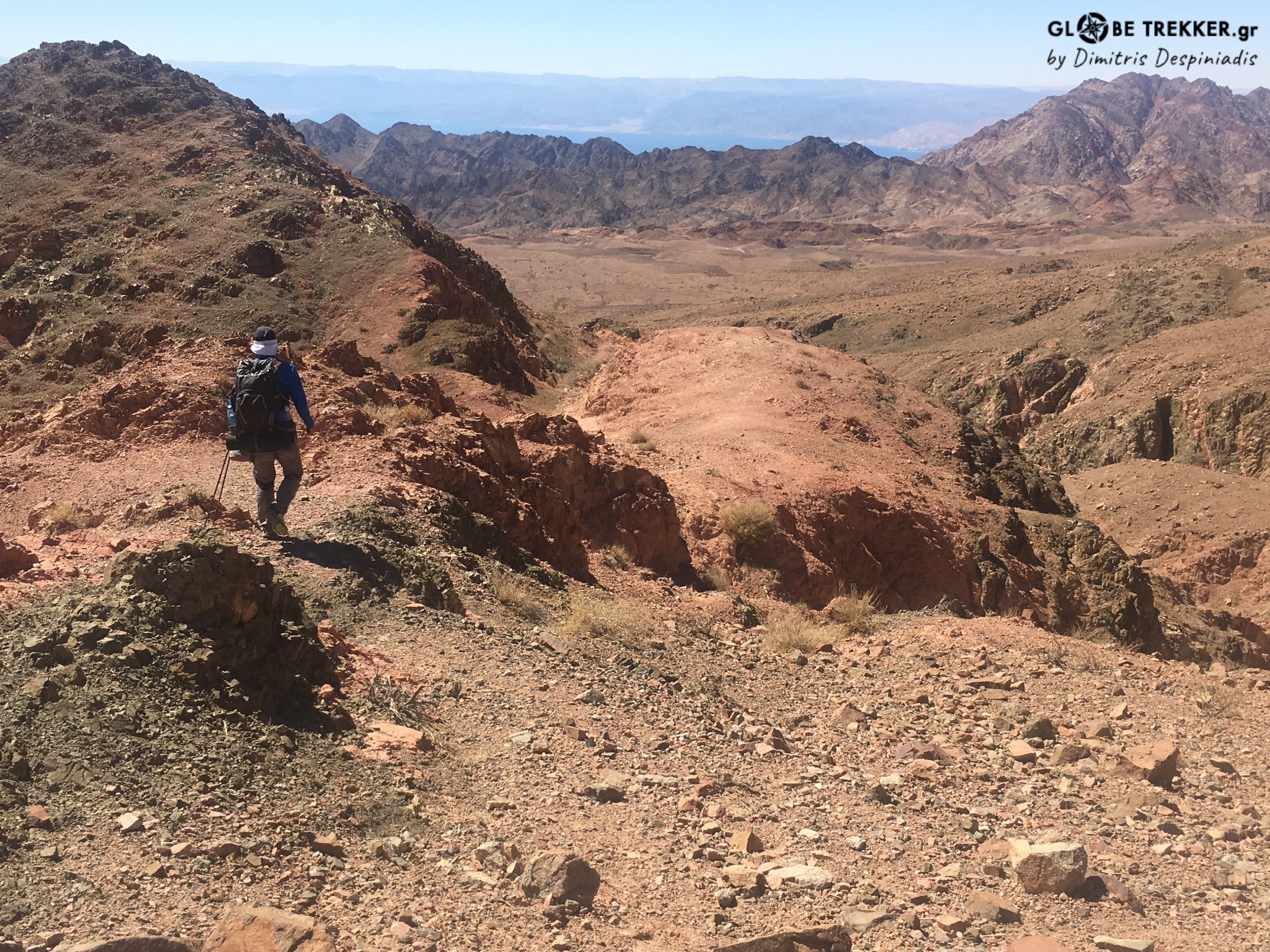
Two hours later we had a deep in the warm waters of the Red Sea.
It was the end of a BEAUTIFUL and TEACHING journey on foot to a crossroads of civilizations, with warm people and highly exotic landscapes!




